Badlands National Park is a highly underrated park in the United States. The colorful buttes, spires, and pinnacles create one of the most photogenic landscapes in the country. Bison and bighorn sheep roam the largest mixed-grass prairie in the United States. The sunrises and sunsets are magical, the hiking trails are short and sweet, and for those looking for more solitude, you can take your pick from a handful of backcountry experiences. Here are the best things to do in Badlands National Park.
Best Things to Do in Badlands National Park
How to Use This Map: Click the icons on the map to get more information about each point of interest. To take this map with you, click the star next to the title of the map which adds it to your Google account. Next, within your Google Maps app, select ‘Saved’ and then select ‘Maps’. This map title will now appear in your list.
1. Drive Badlands Loop Road
If you do one thing in Badlands National Park, it should be a drive along Badlands Loop Road (Highway 240).
This road twists and turns along “the Wall,” a 60-mile stretch of eroded, jagged rocks, that separate the upper and lower prairies.
Badlands Loop Road is a 30-mile, paved road that runs through the most scenic part of the park. Located along this road are overlooks, boardwalk trails, and the jumping off points for backcountry hikes into the interior of the Badlands.
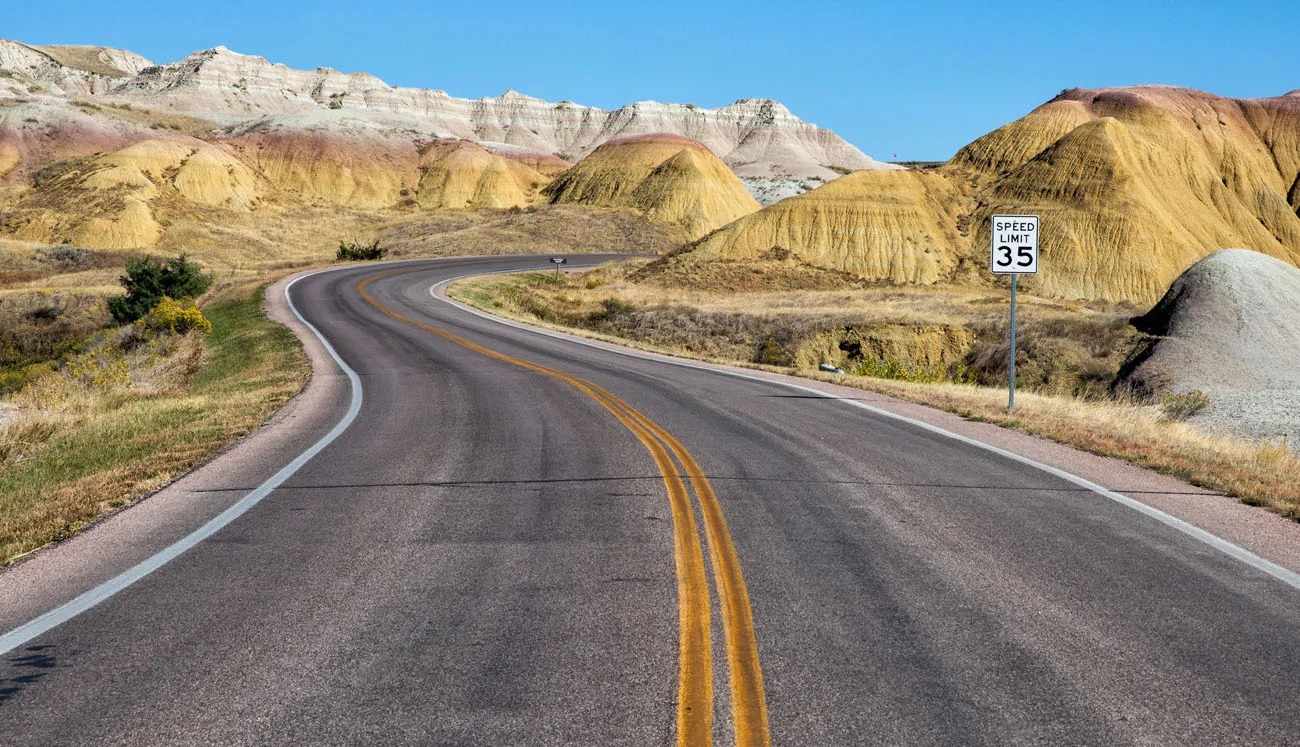
We drove the Badlands Loop Road multiple times and stopped at every single overlook. Here are our seven favorites.
These overlooks are listed in order, starting near Sage Creek Drive and ending at the northeast entrance station.
Pinnacles Overlook
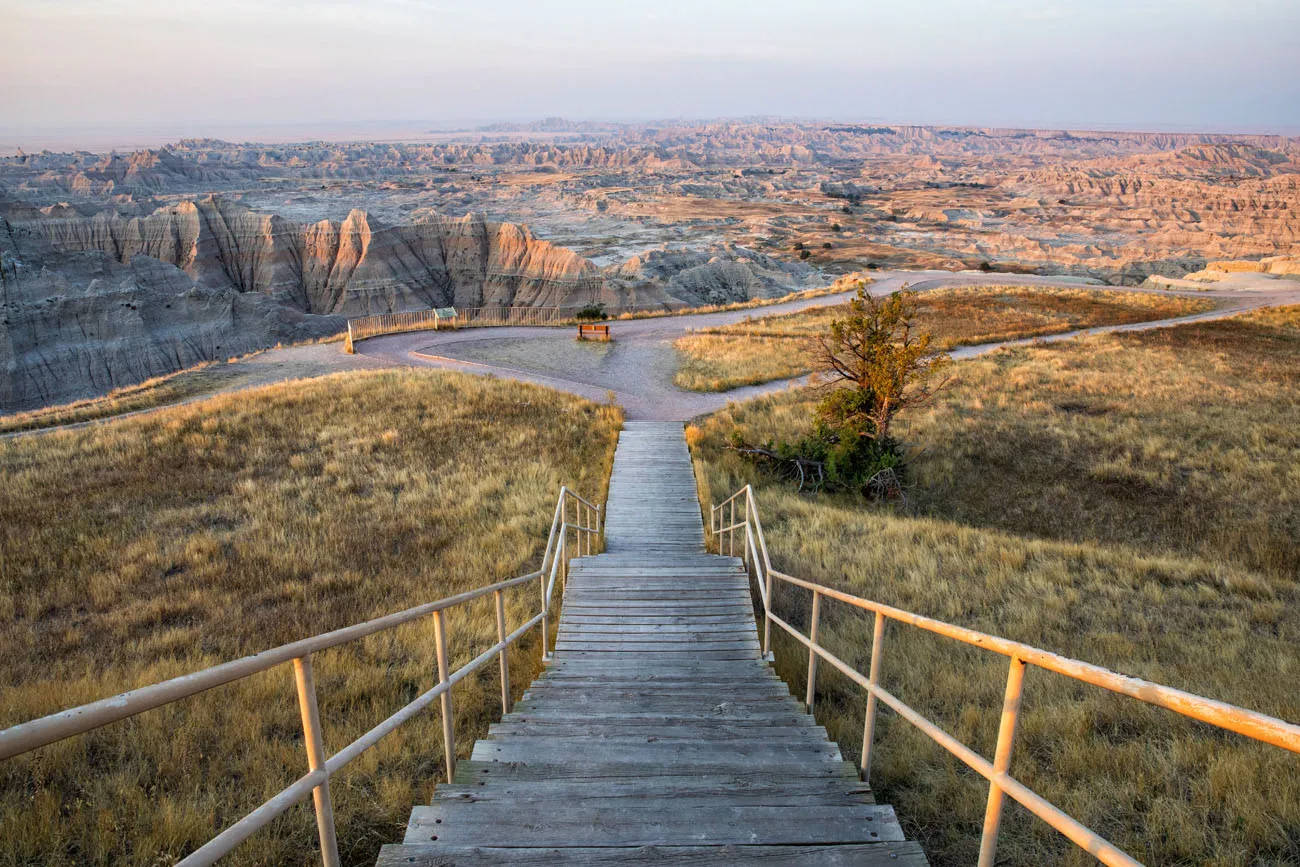
This is one of the most visited overlooks in the park and absolutely worth the visit, at least one time during the day. We were here at sunrise, midday, and sunset and it changes dramatically depending on the lighting. Below I have a photo from each of these different times.
There are several overlooks here as well as the chance to walk a short trail out to another viewpoint.
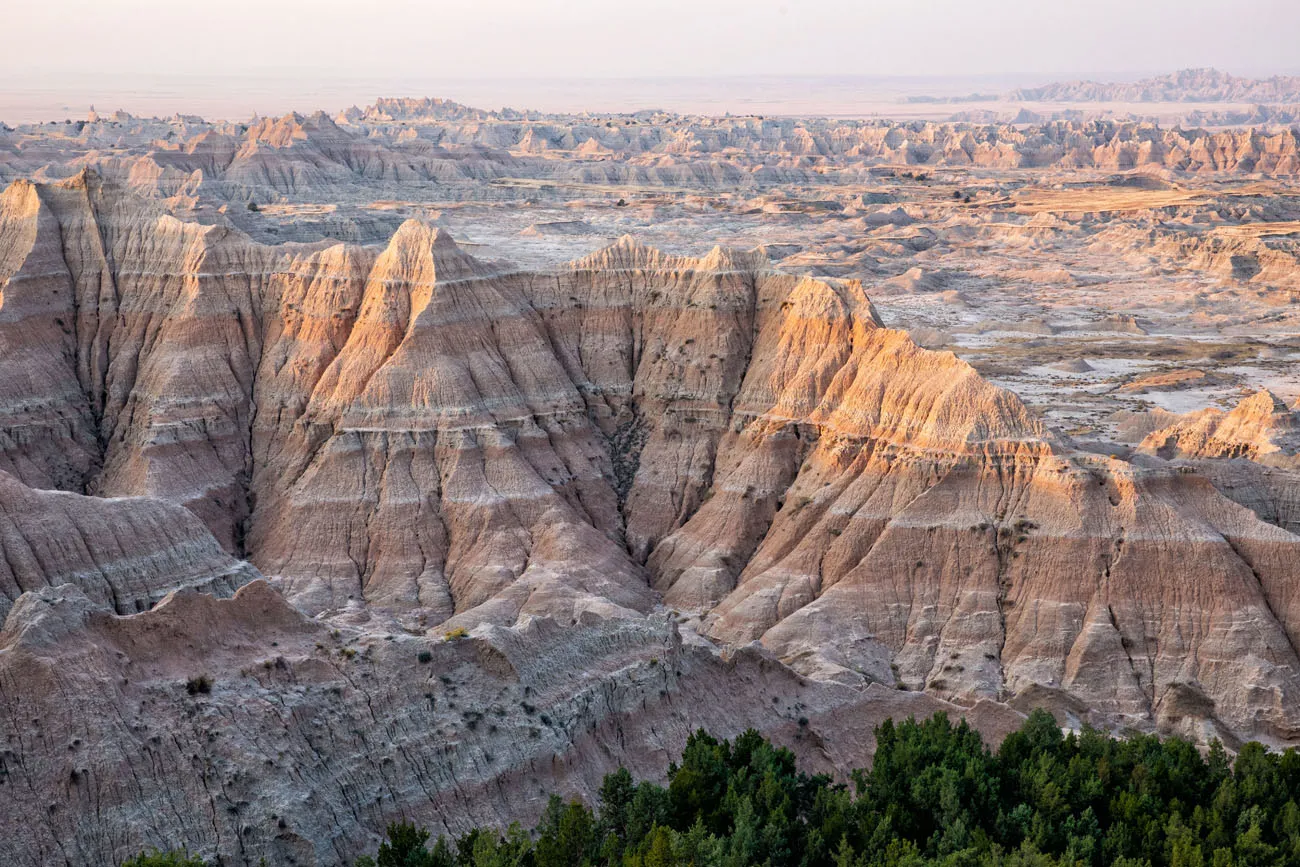
Pinnacles Overlook at sunrise
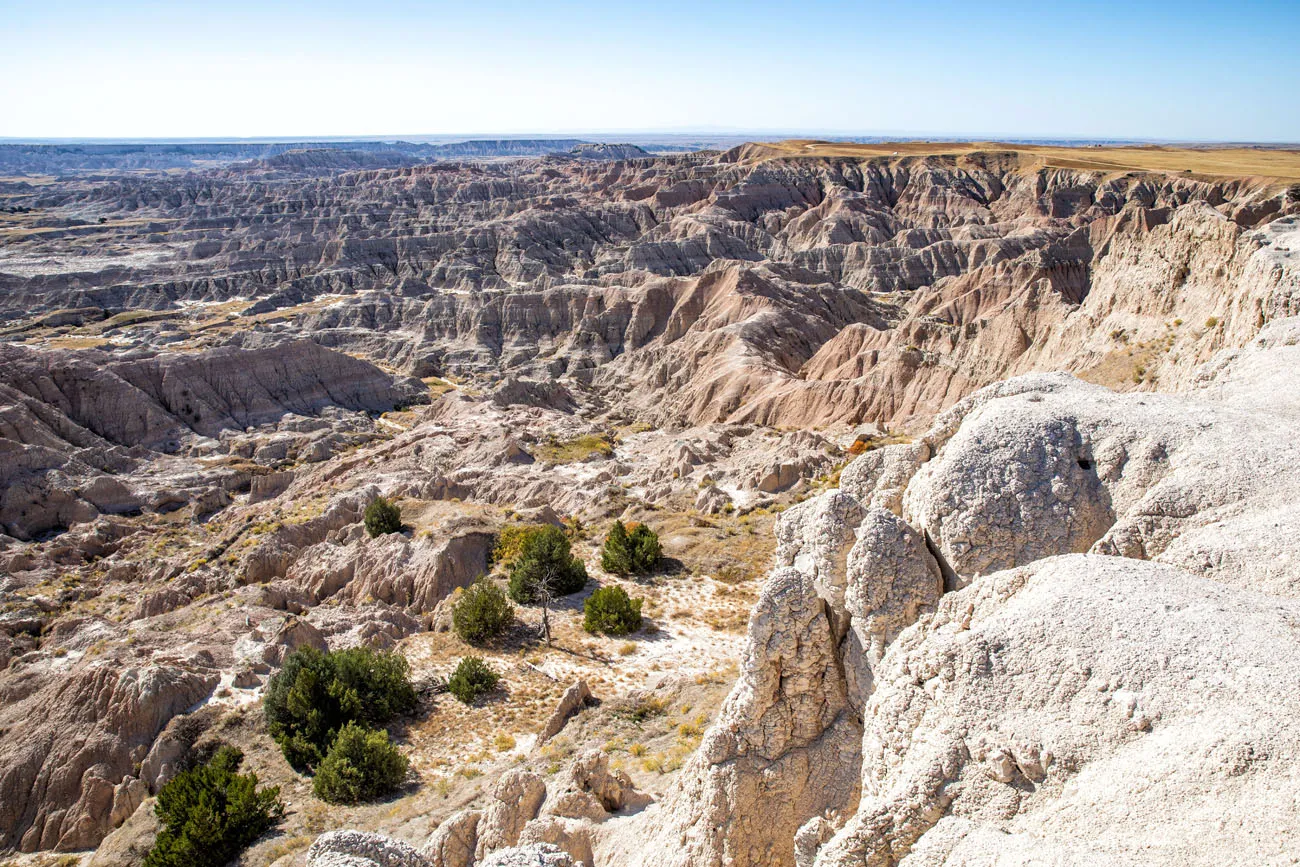
The view midday
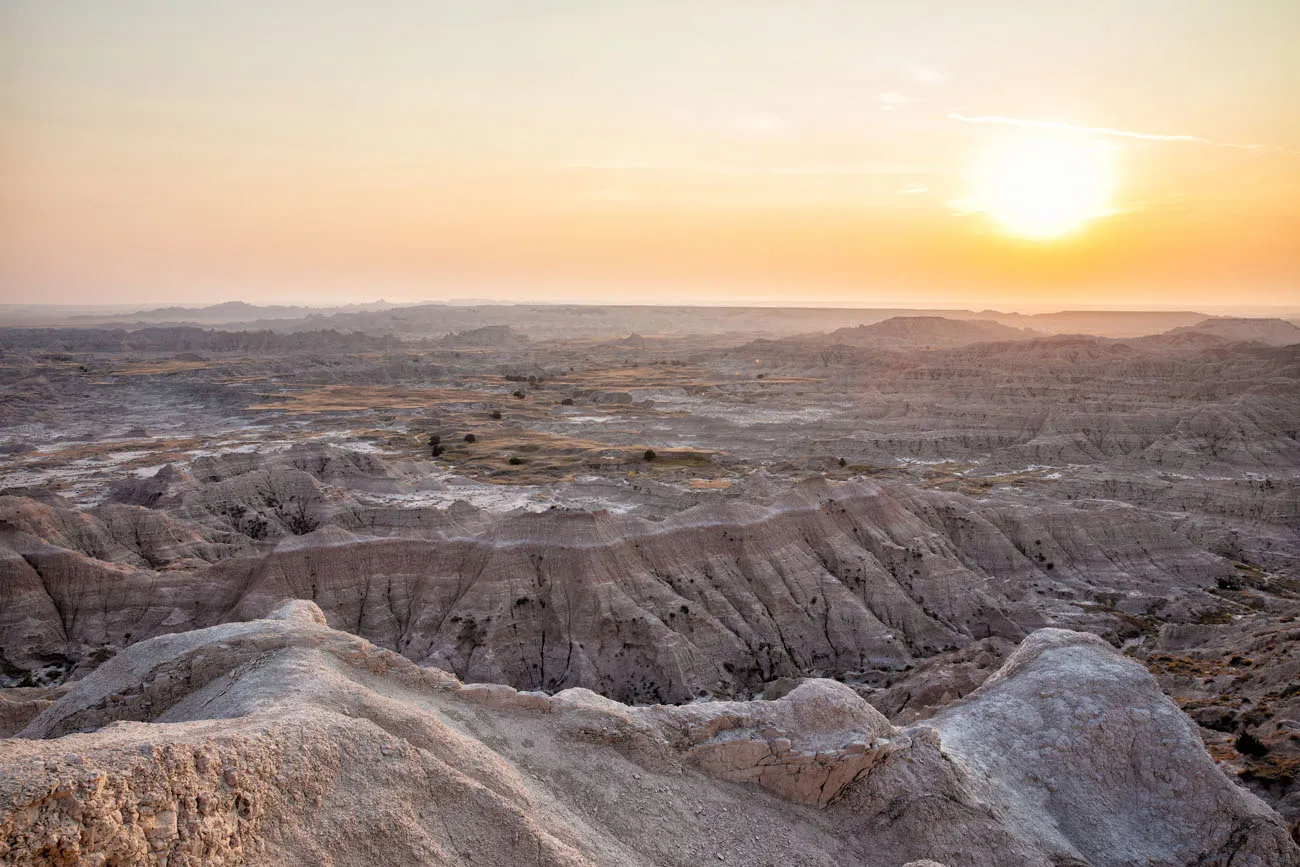
Sunset at the Pinnacles overlook
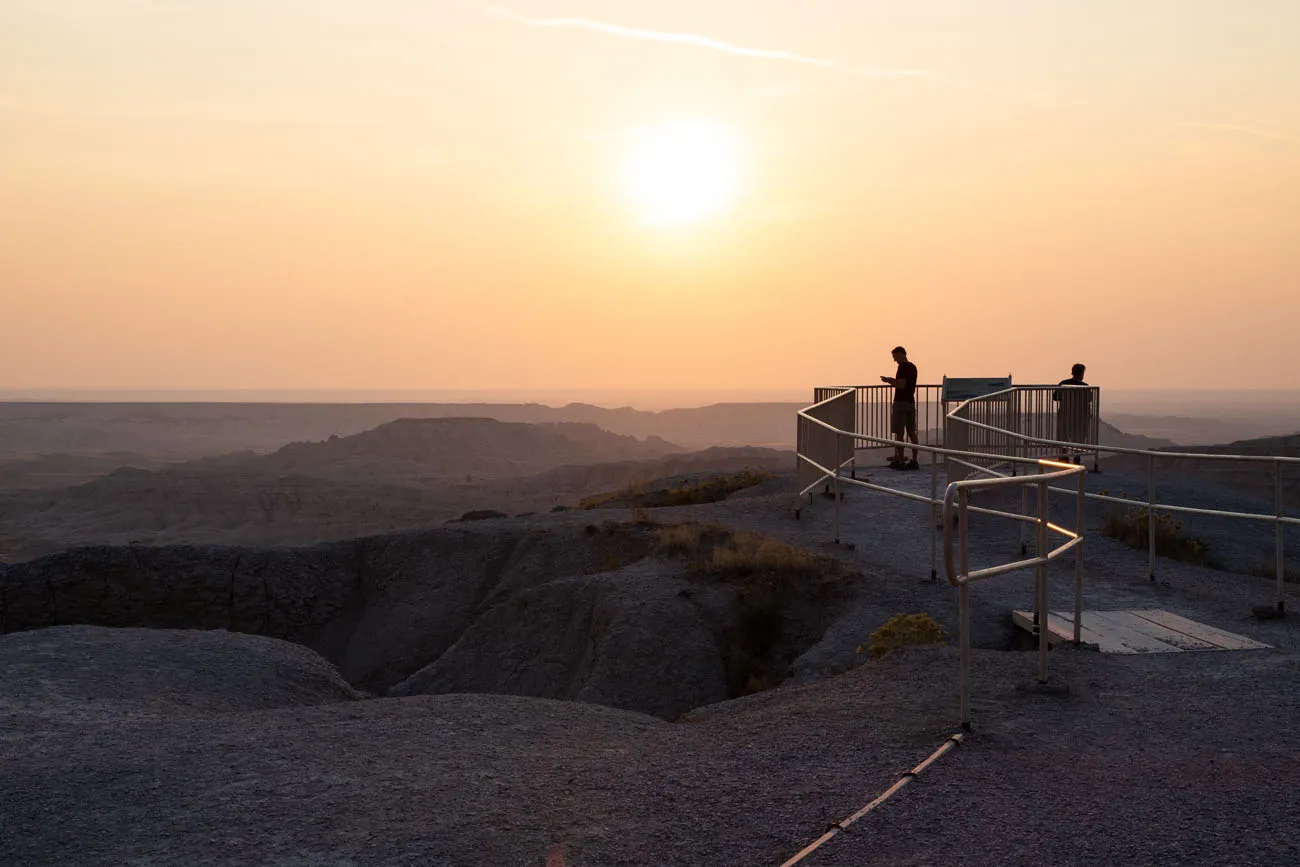
Another sunset photo
Yellow Hills of the Badlands
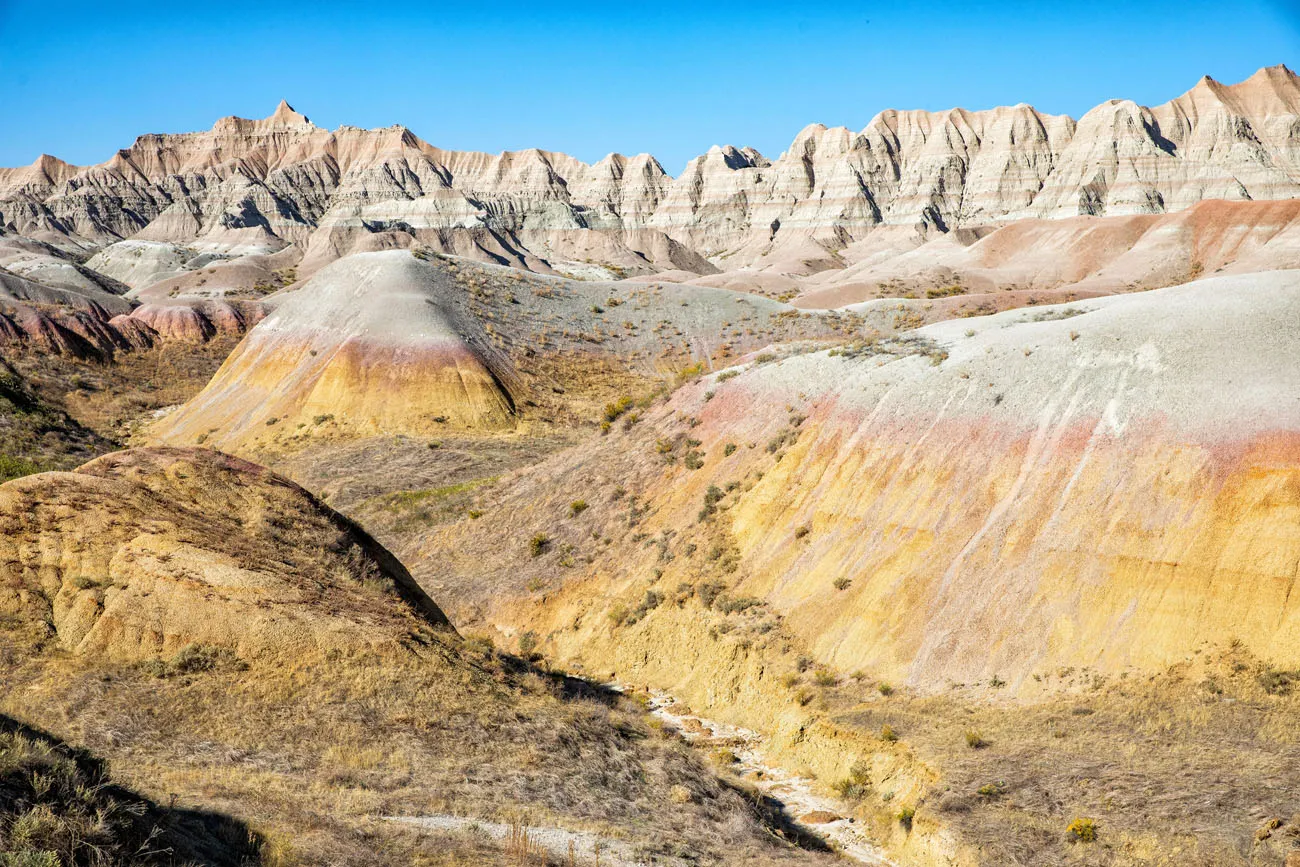
This is not an official overlook but we really liked it. As you approach the Yellow Mound Overlook (the next overlook on our list), you will drive through vibrantly colored yellow hills. There is a turnout here where you can safely park your car and get out to enjoy the view, if you like. GPS coordinates: 43°50’58.2″N 102°12’48.4″W
Yellow Mounds Overlook
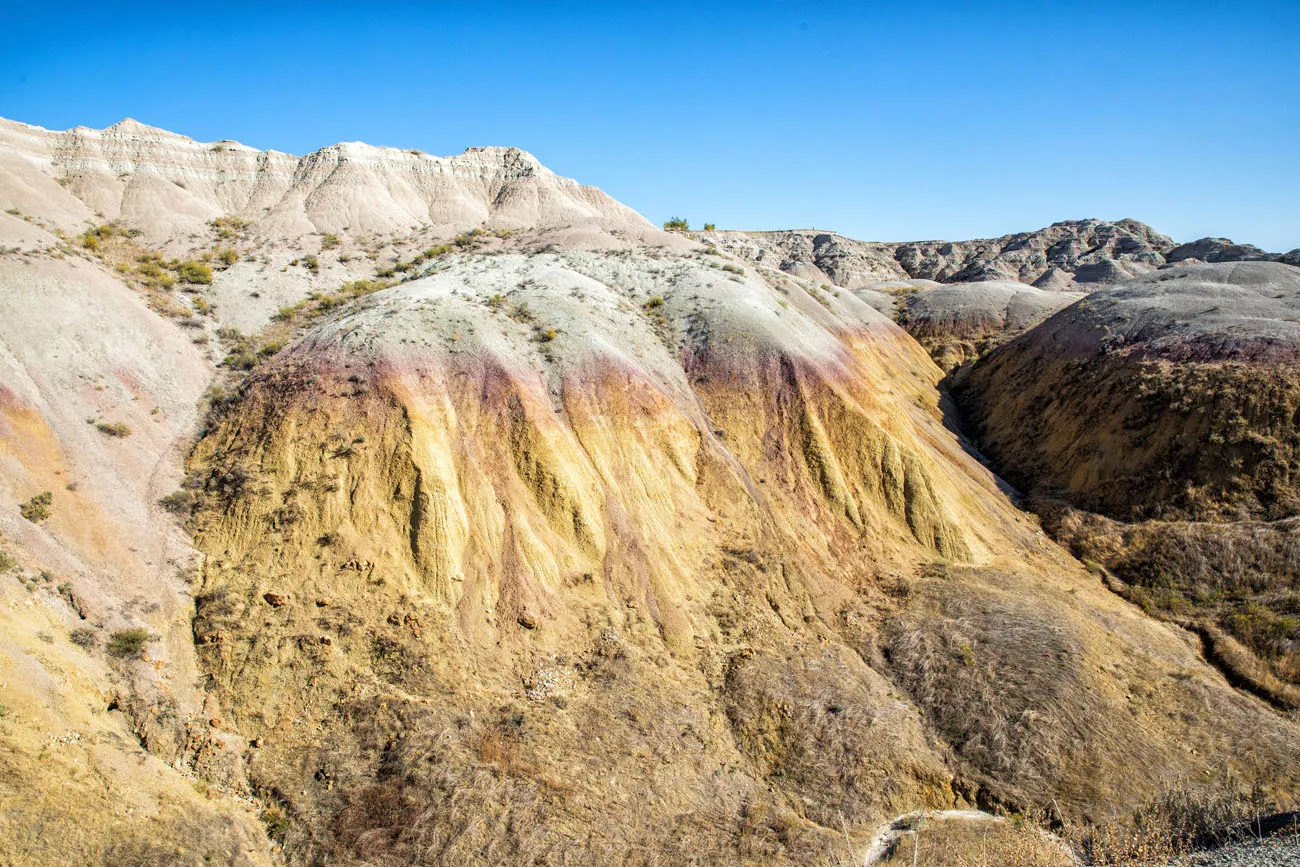
This overlook gives you a view of the yellow hills of the Badlands.
Why are the Yellow Mounds yellow? The yellow color comes from fossil soils, called paleosols, that have weathered and changed color when exposed to the sun.
Conata Basin Overlook
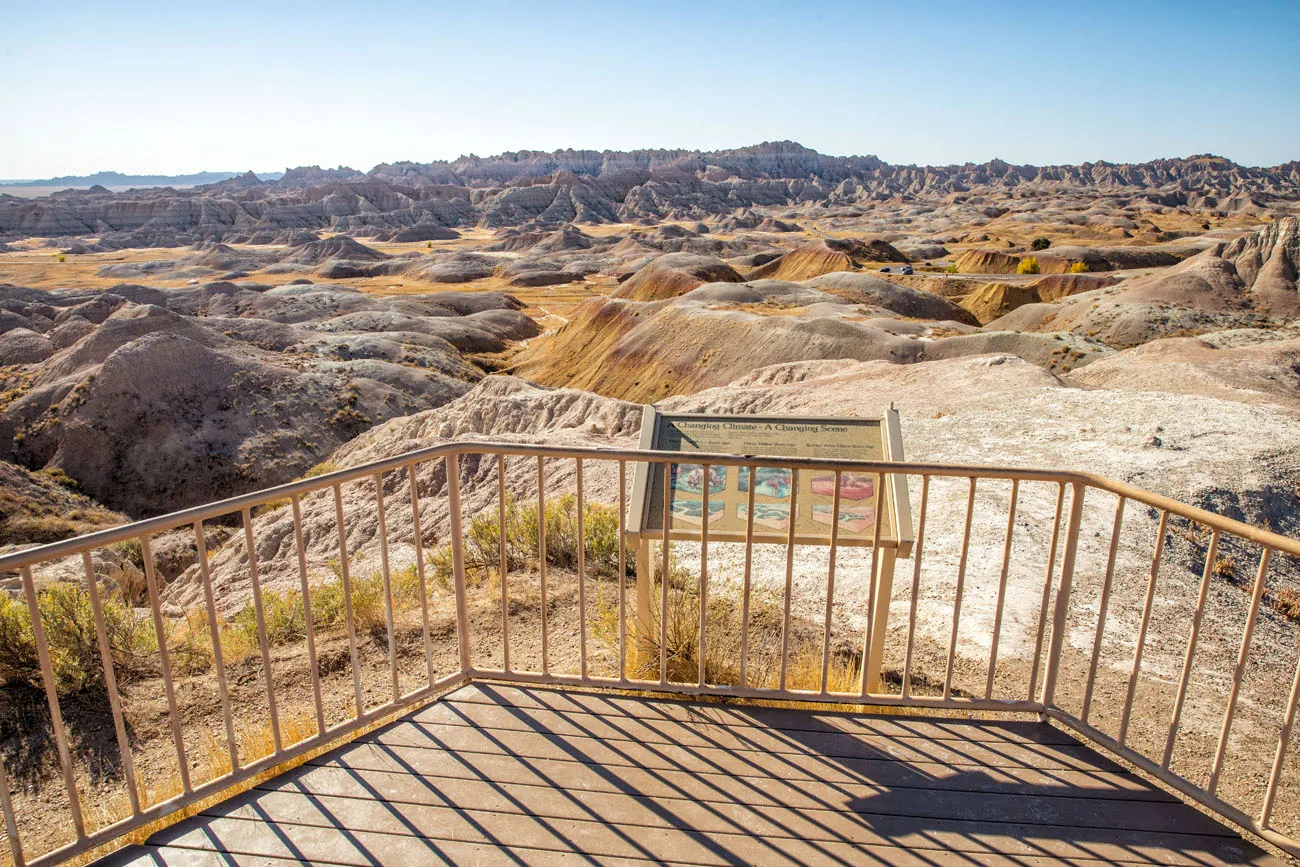
This overlook gives you a view back towards the Yellow Mounds and more multi-colored layers of the Badlands.
Panorama Point
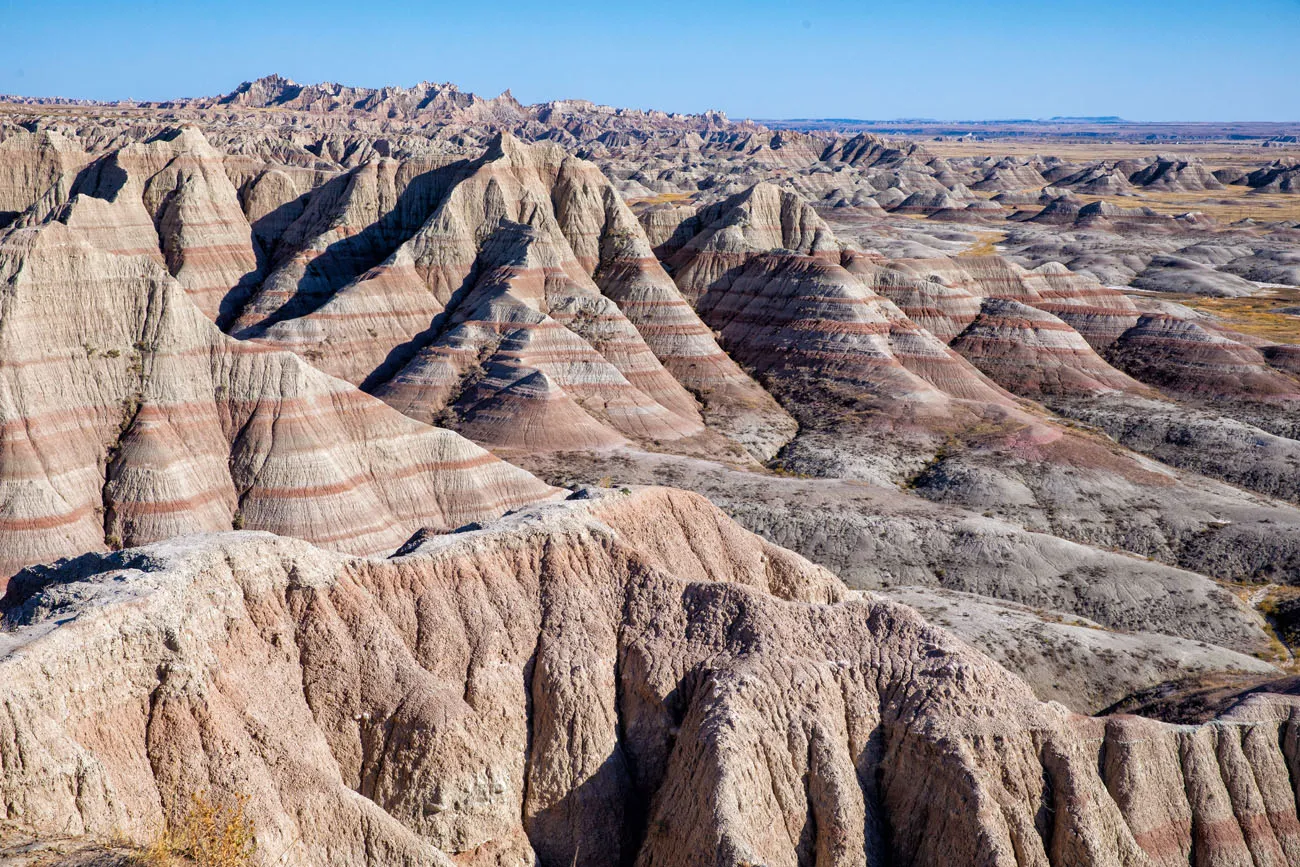
Walk on a short boardwalk trail to this stunning viewpoint. It’s beautiful during the day and gorgeous at sunset.
White River Valley Overlook
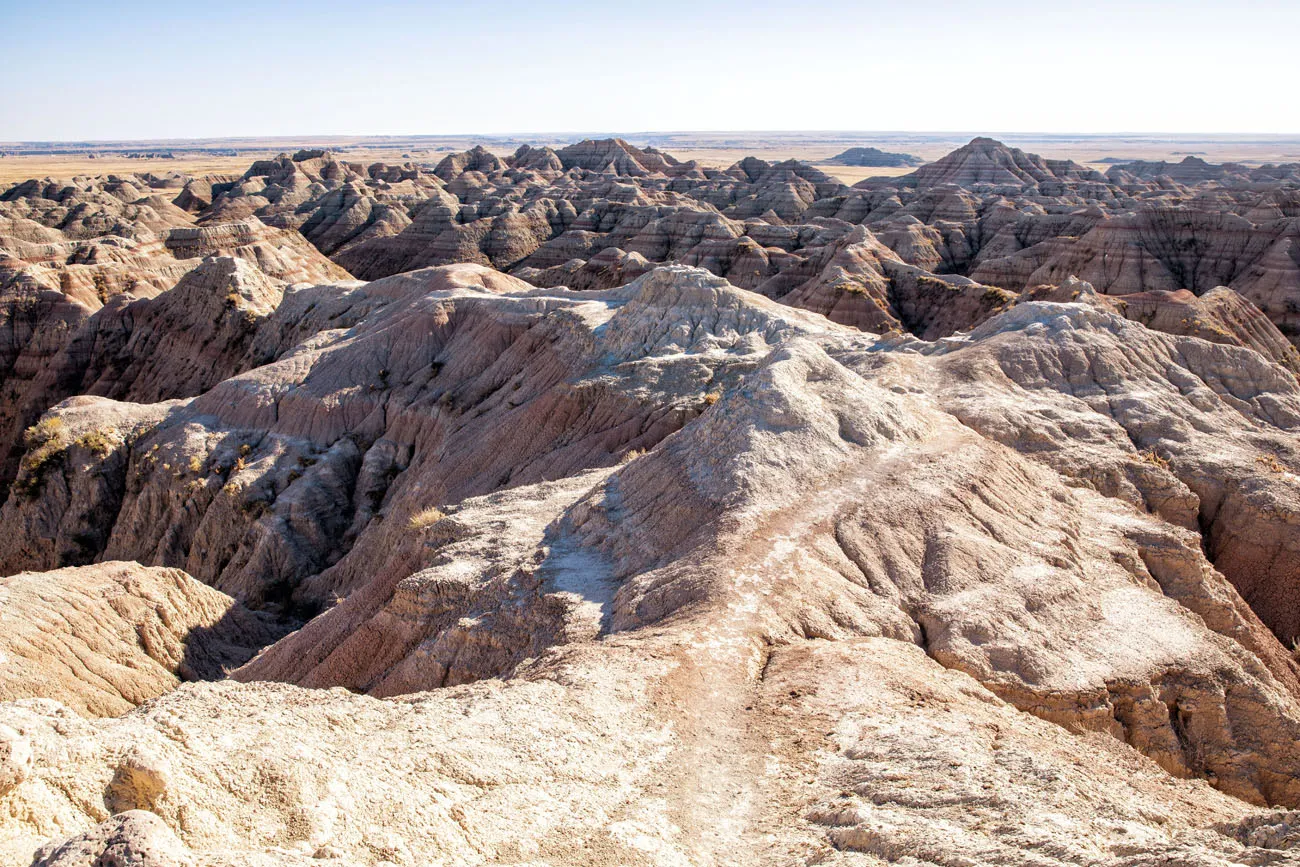
This overlook is one of Tim’s favorites. You can walk short trails further out into the Badlands for an even better view. Just beware! Don’t get near the edge…the ground can be slippery and the cliffs are fragile and can give way under your feet.
Big Badlands Overlook
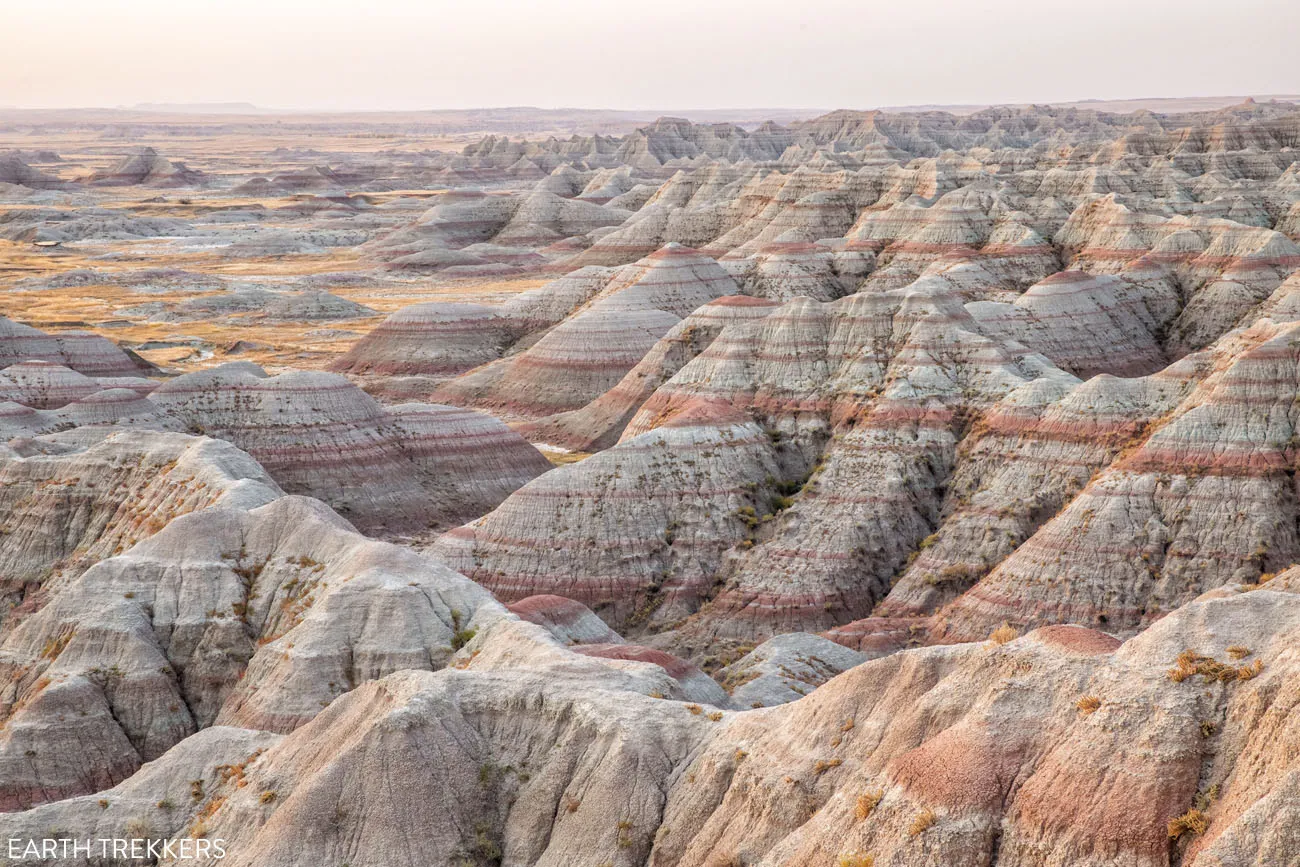
In my opinion, this is the best overlook in the park (Pinnacles is #2). From the overlook, you gaze out at over an enormous section of zebra-striped hills. The view is jaw-dropping and this is a magical place at sunrise.
Planning Your Time
Badlands Loop Road runs from the Northeast Entrance Station to Sage Creek Road. If you drove this road without stopping, it would take about an hour and fifteen minutes, one-way. Once you add on overlooks and a few, short walks/hikes, this drive can take half to a full day, depending on what you choose to do.
2. Watch the Sunrise Over the Badlands
Sunrise and sunset are magical in the Badlands. But sunrise is our favorite of the two. Why? For one thing, there are much fewer people who are willing to roll out of bed and drive into the park in the early morning hours. But the lighting is also very special.
We watched the sunrise from the Big Badlands Overlook and it is one of our favorite national park sunrise experiences (Bryce Canyon and the Grand Canyon are also spectacular).
From the Big Badlands Overlook, you can either watch the sunrise from the viewing platform (a short walk from the parking lot) or you can hike out into the hills. It’s worth the short walk since you can get closer to the striped rock formations and colorful pinnacles. The cover photo for this post was taken at the Big Badlands Overlook.
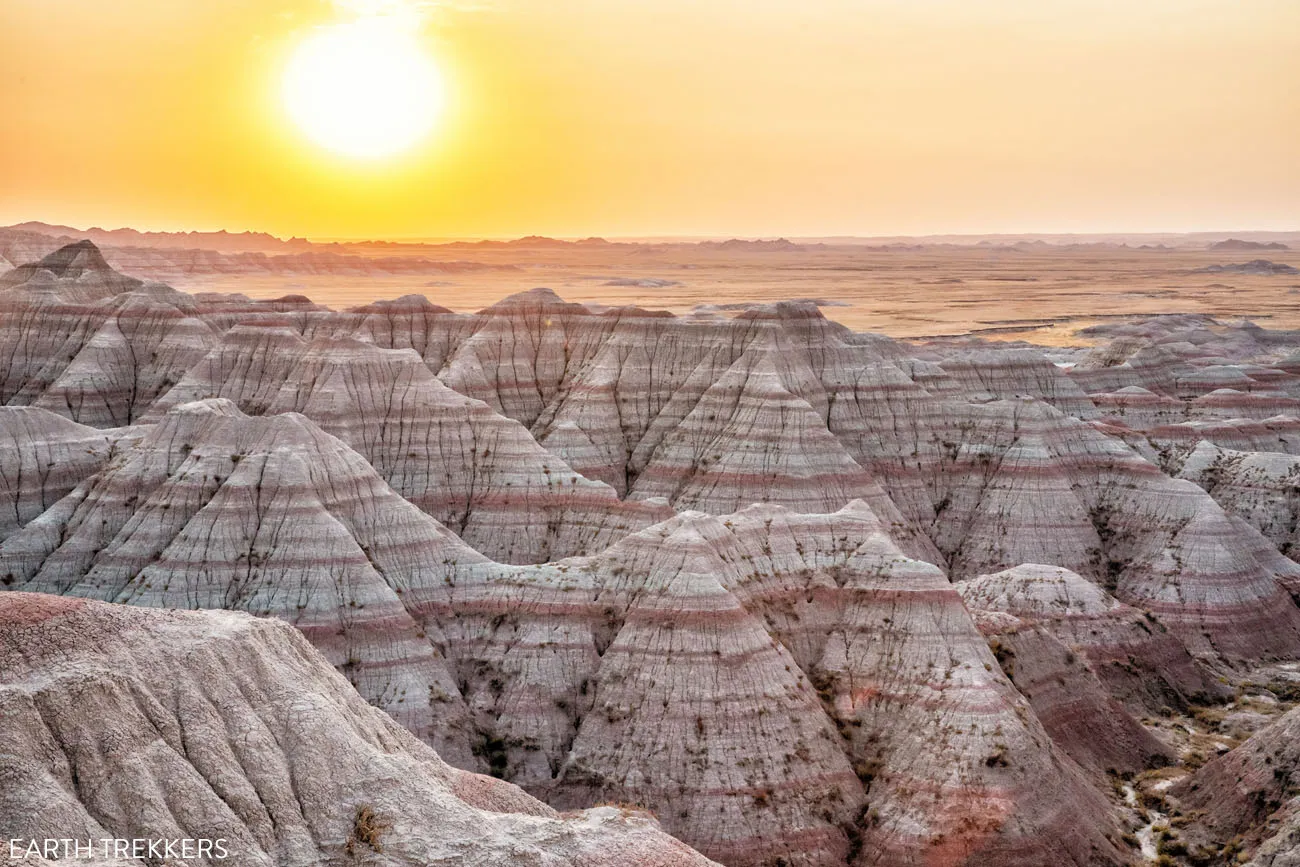
3. Sunset is Amazing, Too
This is easier for most people, since you don’t have to wake up early. Plus, it’s the perfect way to end your day in the park.
Before our trip to the Badlands, I read that the top sunset spots are Conata Basin, the Pinnacles, and Norbeck Pass. We tried Conata Basin and weren’t impressed. Pinnacles is great but expect big crowds.
Our favorite sunset spot is Panorama Point. We were the only ones here and the view is incredible.
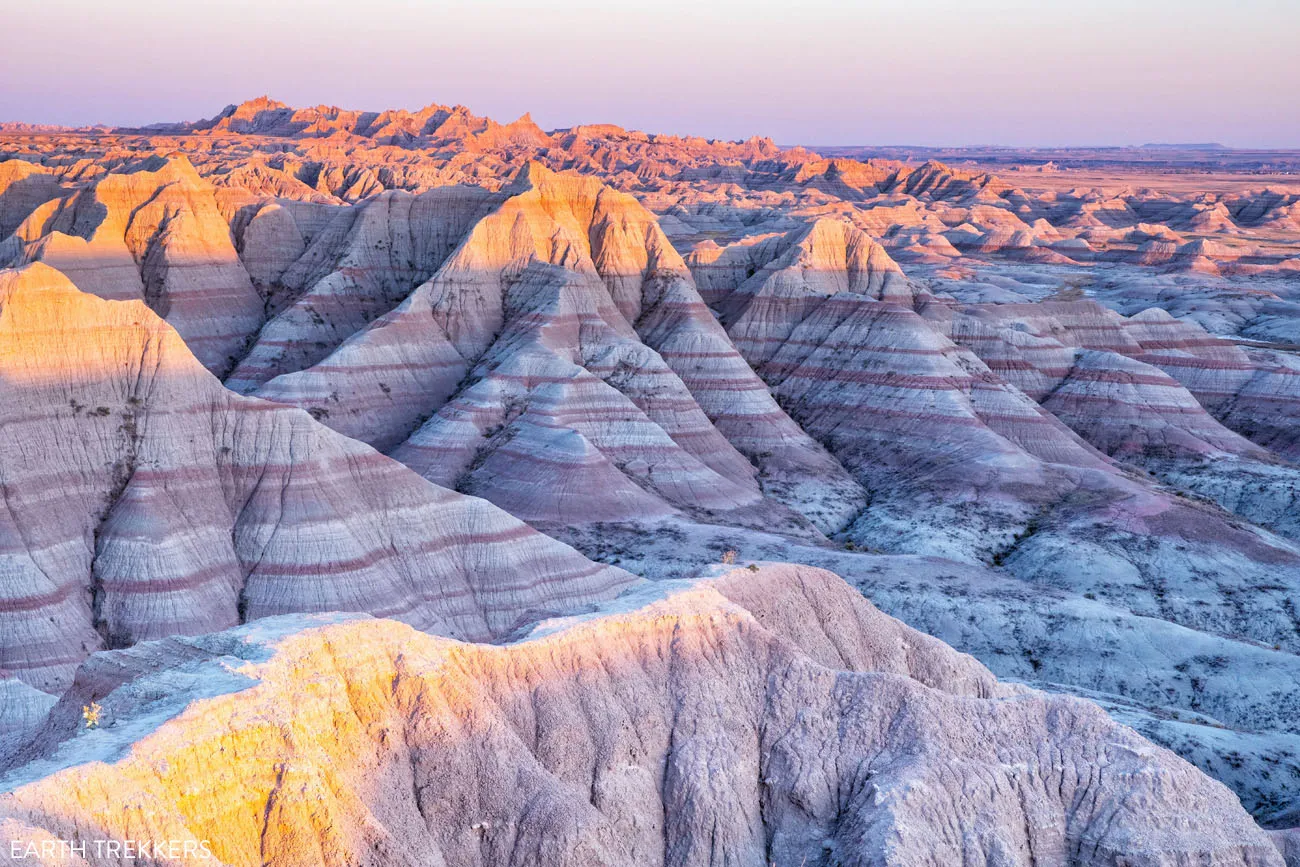
Photography Tip: The best time to photograph the Badlands is during the two hours around sunrise and sunset (the Magic Hour or Golden Hour). The sun is low on the sky, the lighting is soft, and you will not have the harsh contrasts and shadowing that you get midday. The worst time to photograph the Badlands is between 10 am and 2 pm, when shadows on the pinnacles and spires make photography difficult.
4. The Notch Trail: The Best Short Adventure in the Park
The Notch Trail is pure fun. This hike is great for adventurous kids and adults.
It’s just 1.5 miles round trip and features a walk through a scenic canyon, a climb up a wooden ladder, a brief walk along a cliff trail, and ends with a view of the amazing scenery of the Badlands.
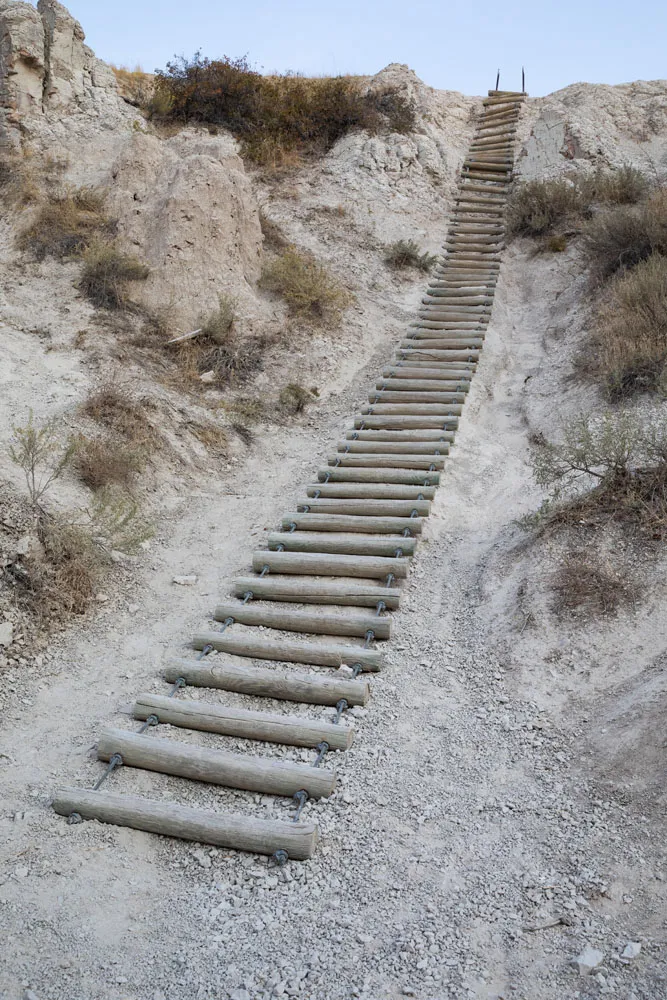
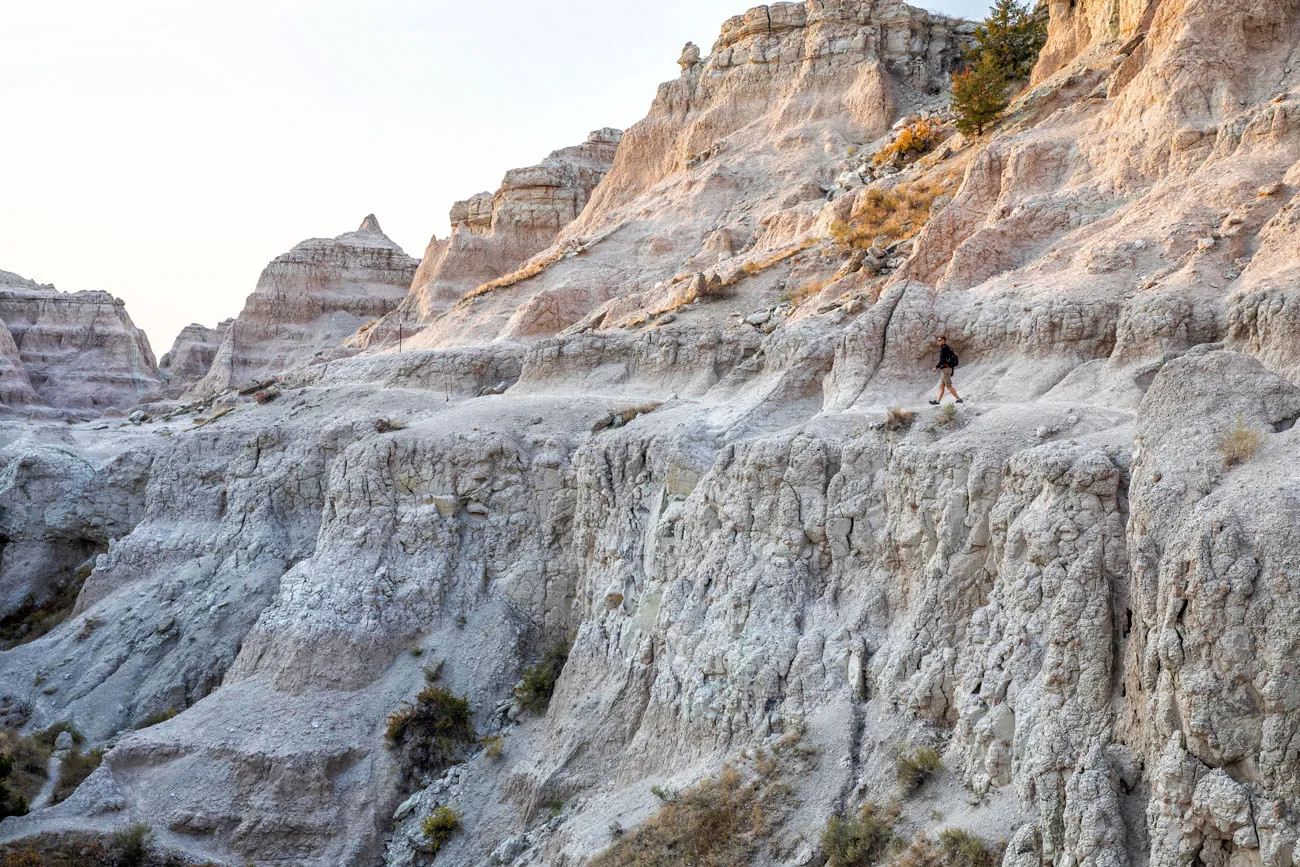
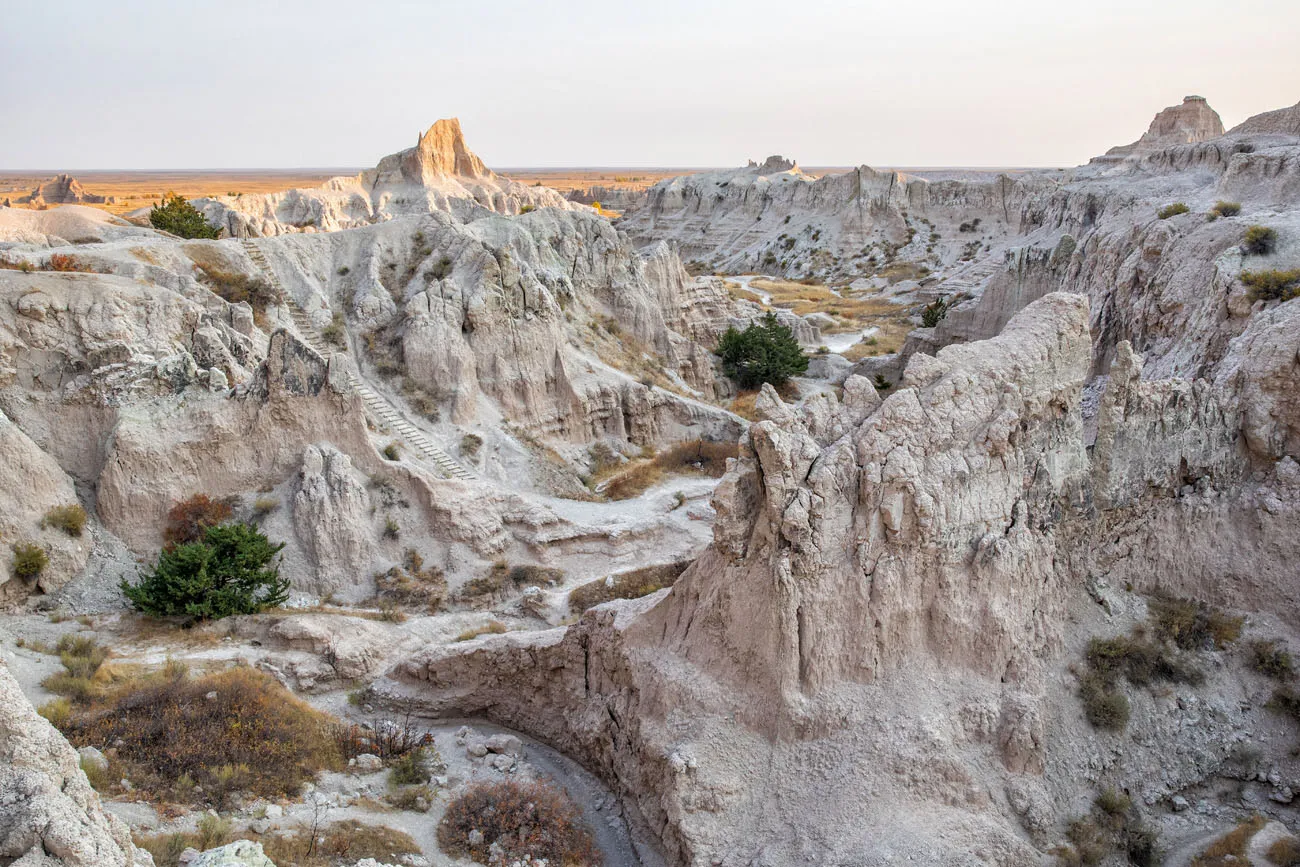
There is a short section where the trail is only 5 feet wide. If you have a fear of heights or are planning to do this with young kids, you can skip this section. At the base of the ladder you have a choice to make. You can either climb up the ladder and walk the cliff trail, or follow the trail through the canyon floor until it rejoins with the higher trail.
LEARN MORE: How to Hike the Notch Trail
5. The Castle Trail: Go Farther into the Badlands
The Castle Trail is a 5-mile point-to-point trail that cuts through the heart of the Badlands. It connects two points on Badlands Loop Drive: the Fossil Exhibit Trail with the Window and Door Trails.
There are many different ways that you can hike the Castle Trail. The best way is to do it point-to-point, but you will need someone to drop you off and pick you up. You can also hike it out-and-back for a total of 10 miles. Your third option is to just hike a section of it.
We hiked the entire Castle Trail and our favorite section was the Saddle Pass – Castle Trail – Medicine Root Loop. This hike is 4.7 miles long and takes about 2 hours. The first climb up Saddle Pass is strenuous but the rest of the trail is easy. Along the way, you are treated to views across the prairieland, rocky pinnacles, and you might even get to see bighorn sheep or pronghorn.
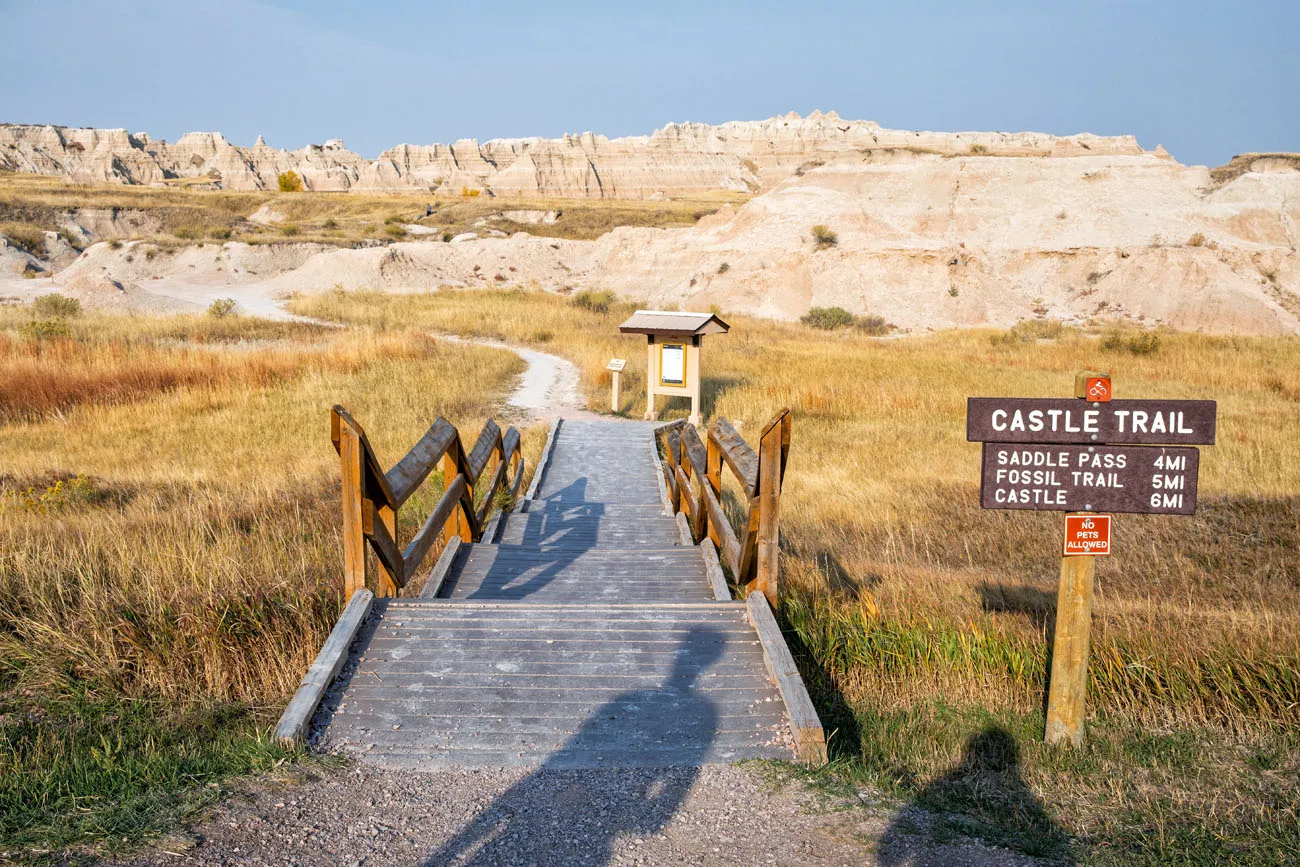
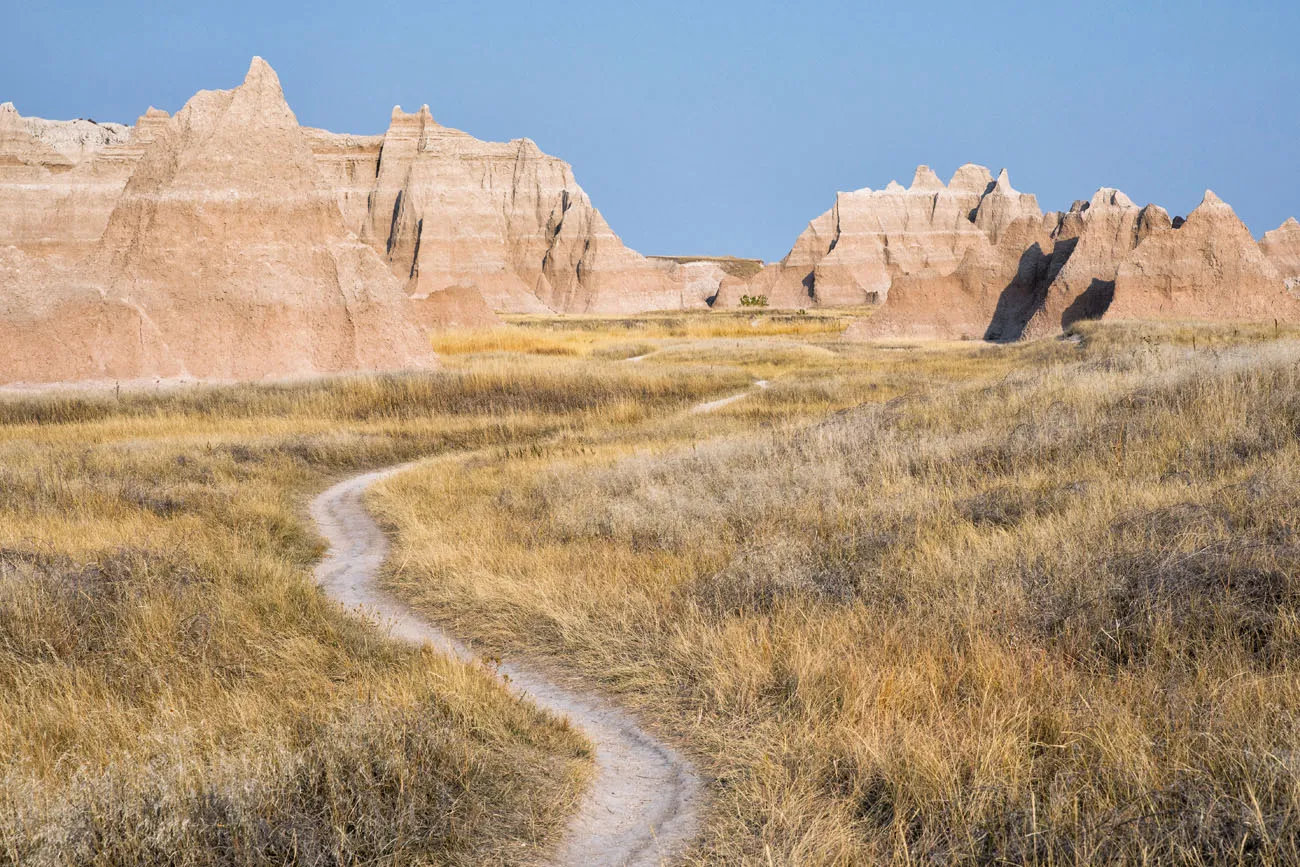
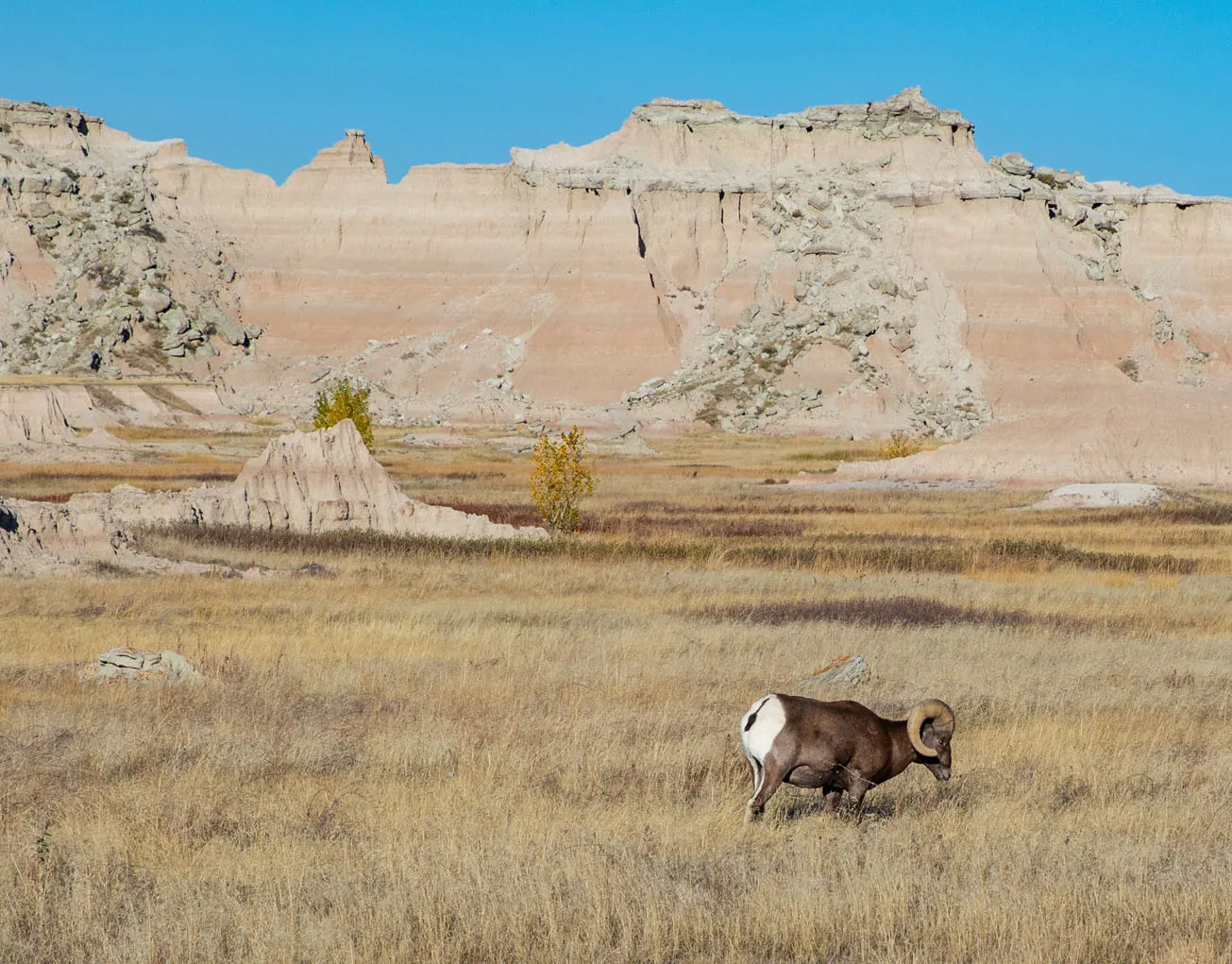
Bighorn sheep
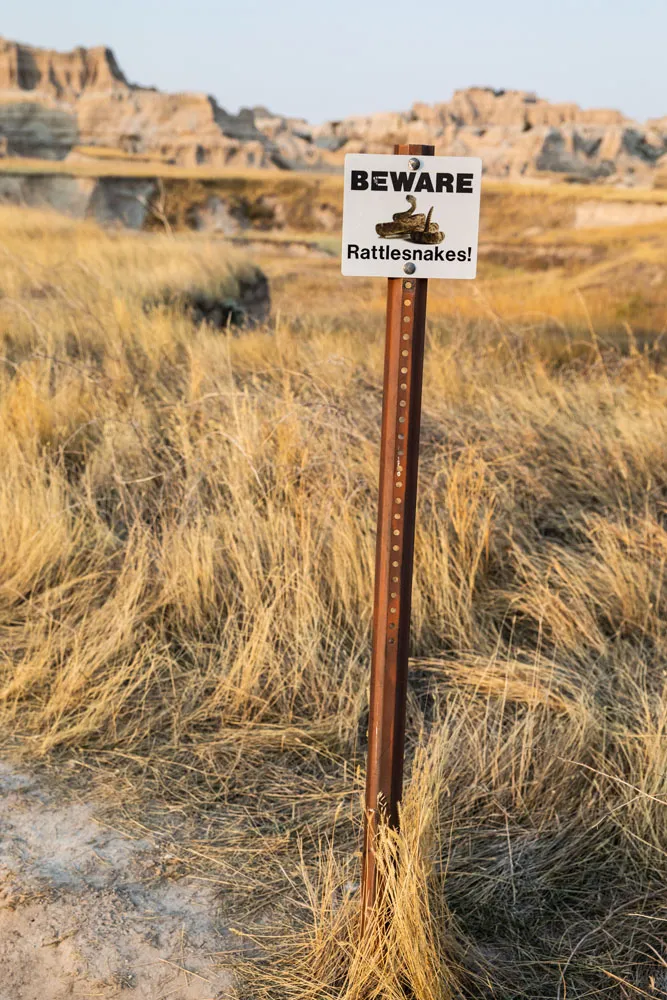
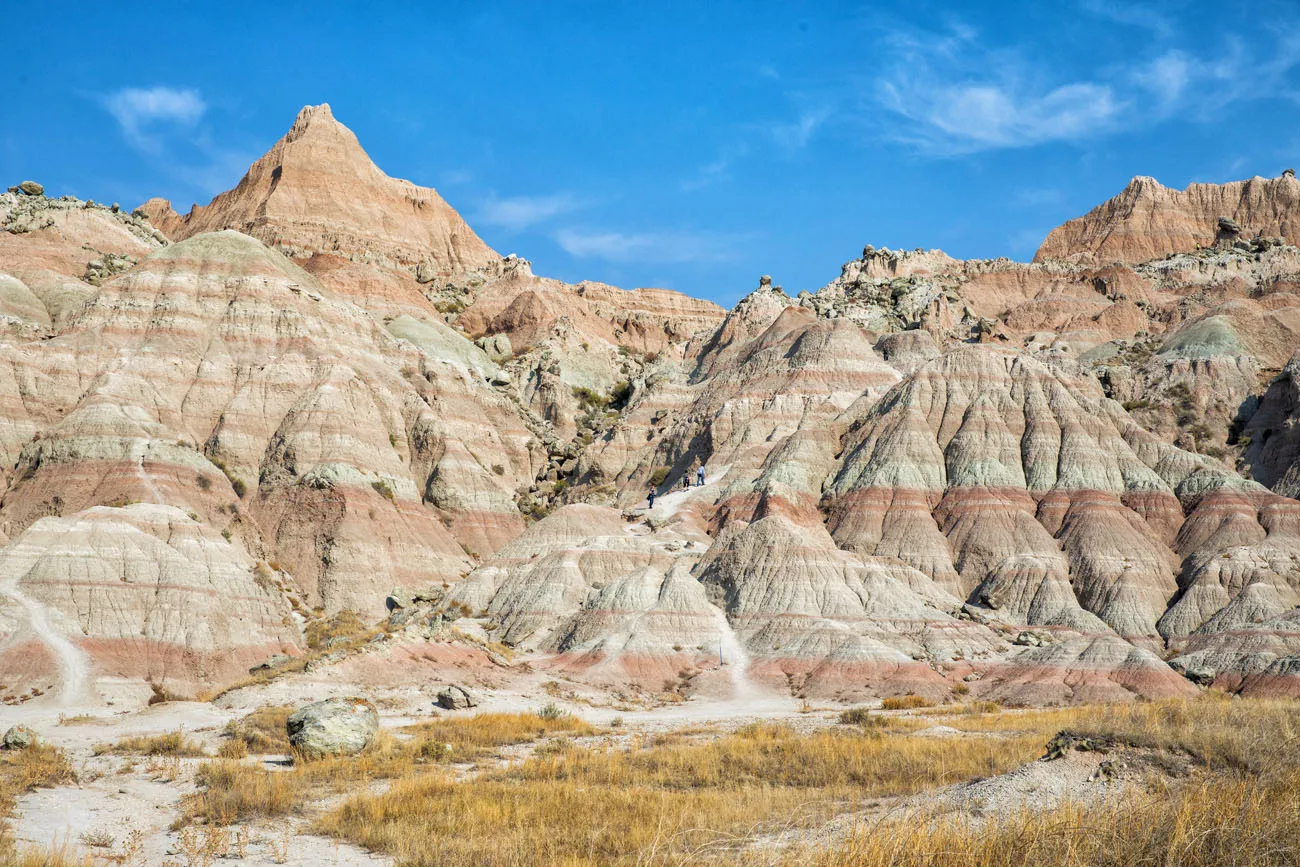
Saddle Pass Trail. This trail is a short, steep, strenuous climb up into these hills where it later joins the Castle Trail.
LEARN MORE: How to Hike the Castle Trail
6. Go Back in Time on the Fossil Exhibit Trail
The Badlands has one of the most concentrated mammal fossil beds in the world. The Fossil Exhibit Trail is the best place to learn about these discoveries.
The Fossil Exhibit Trail is just .25 miles long. A boardwalk trail takes you past 75 million years of history and the animals that once inhabited this land.
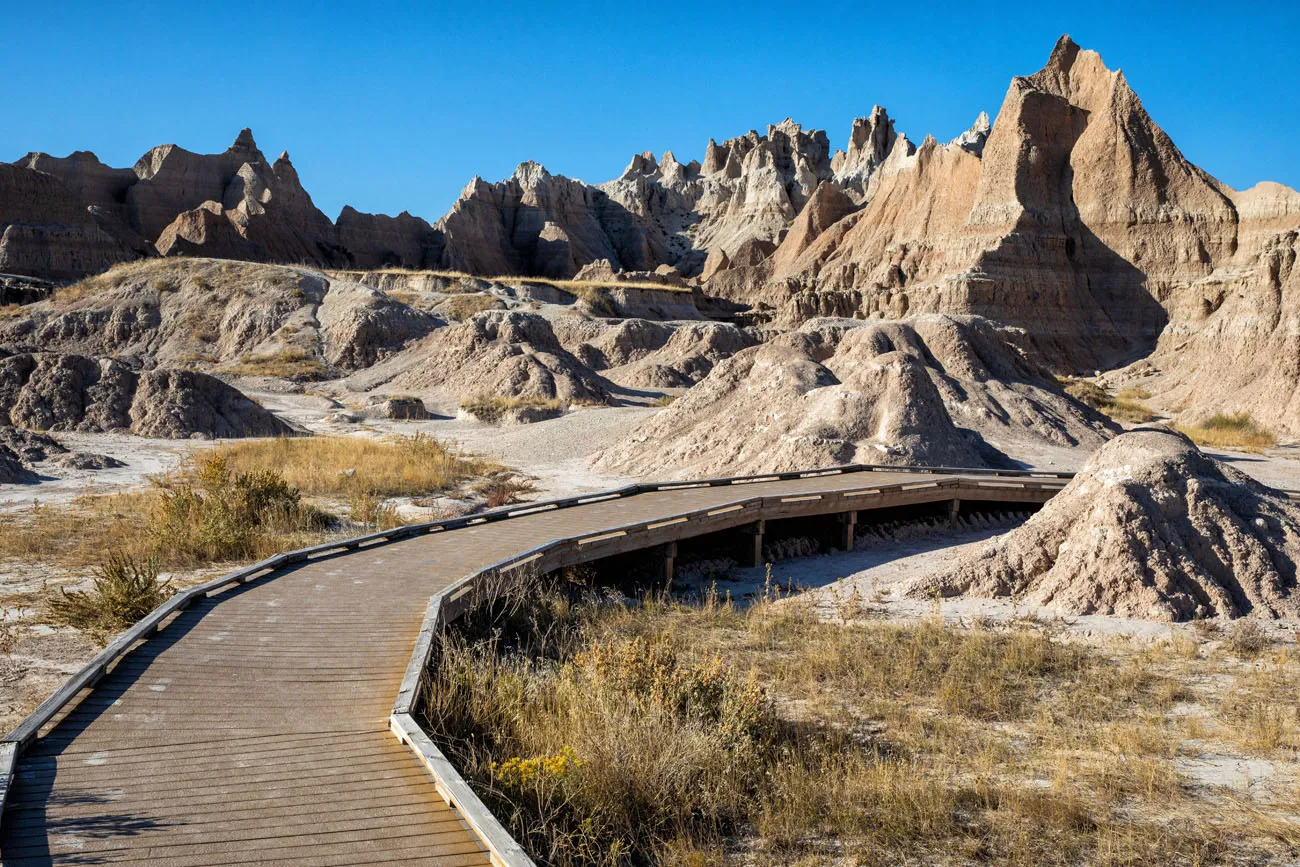
7. Window Trail
This is another very short, boardwalk trail. Just .25 miles long, the trail ends at the Window, a viewpoint of “the Wall” and the pinnacles and spires that make the Badlands so famous.
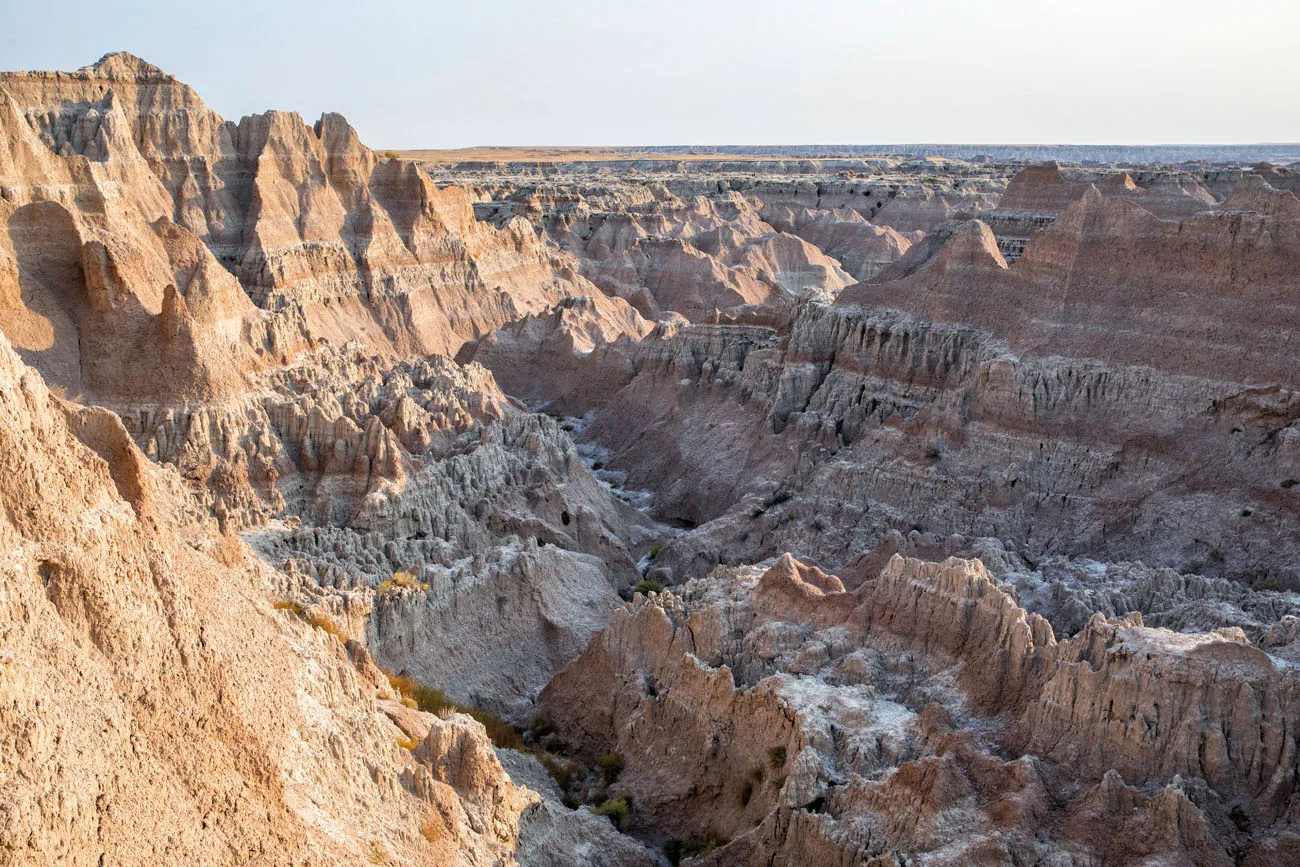
While in Badlands National Park, please practice the seven principles of Leave No Trace: plan ahead, stay on the trail, pack out what you bring to the hiking trail, properly dispose of waste, leave areas as you found them, minimize campfire impacts, be considerate of other hikers, and do not approach or feed wildlife.
8. Hike the Door Trail
If you want to get up close with amazing rock formations of the Badlands without a full-on hike, this is a great option. The Door Trail is 0.75 miles long (round-trip), flat, and great for almost all ability levels.
The trail starts off as a boardwalk (100 meters of the hike is on a boardwalk). Once off the boardwalk, you will hike 800 meters into the Badlands, on a rough, uneven terrain. The national park service lists this part of the trail as strenuous but I think most people will find it to be easy but fun. Kids will love this short, fun hike.
Over the 800 meters, the trail descends down into a field of fossil beds and the entire way you have views of the pinnacles and spires of the Badlands.
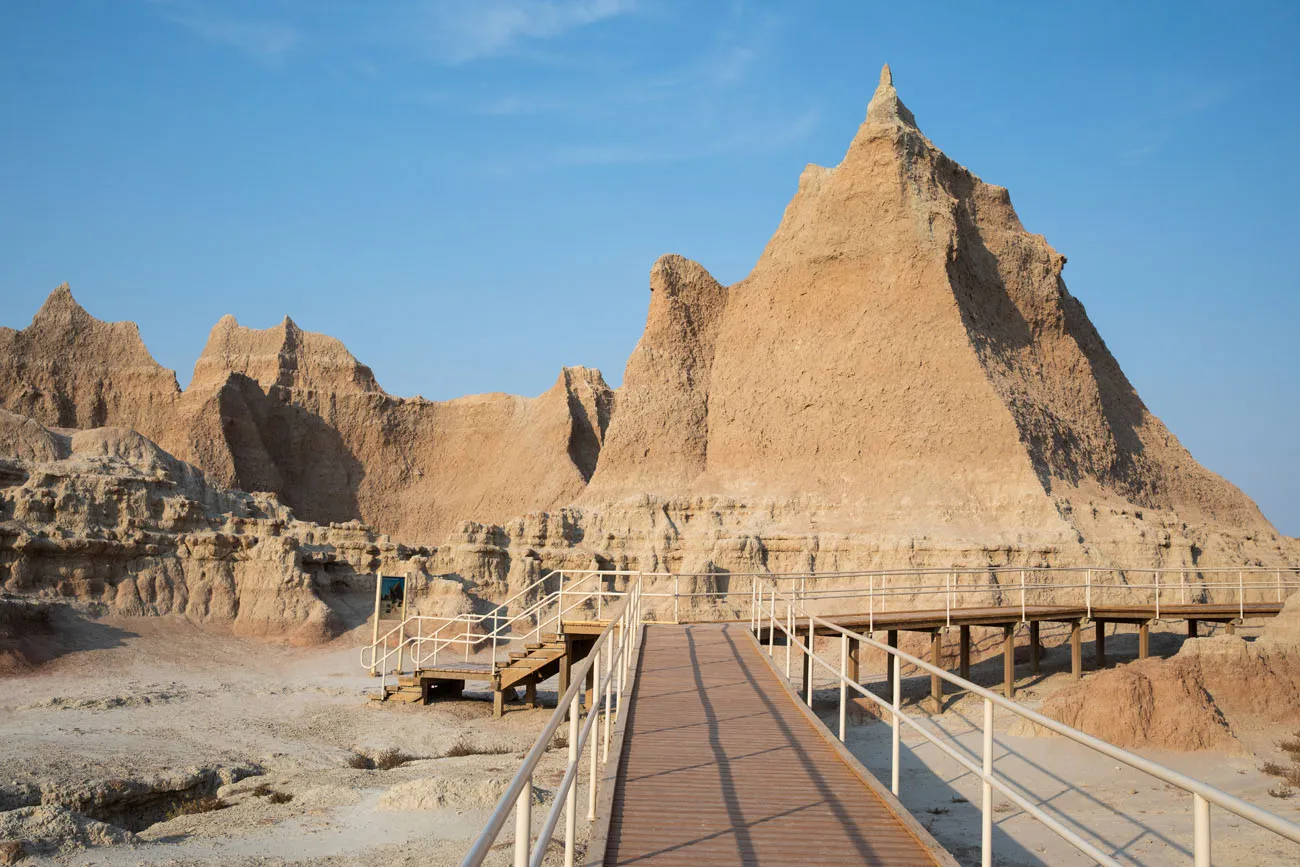
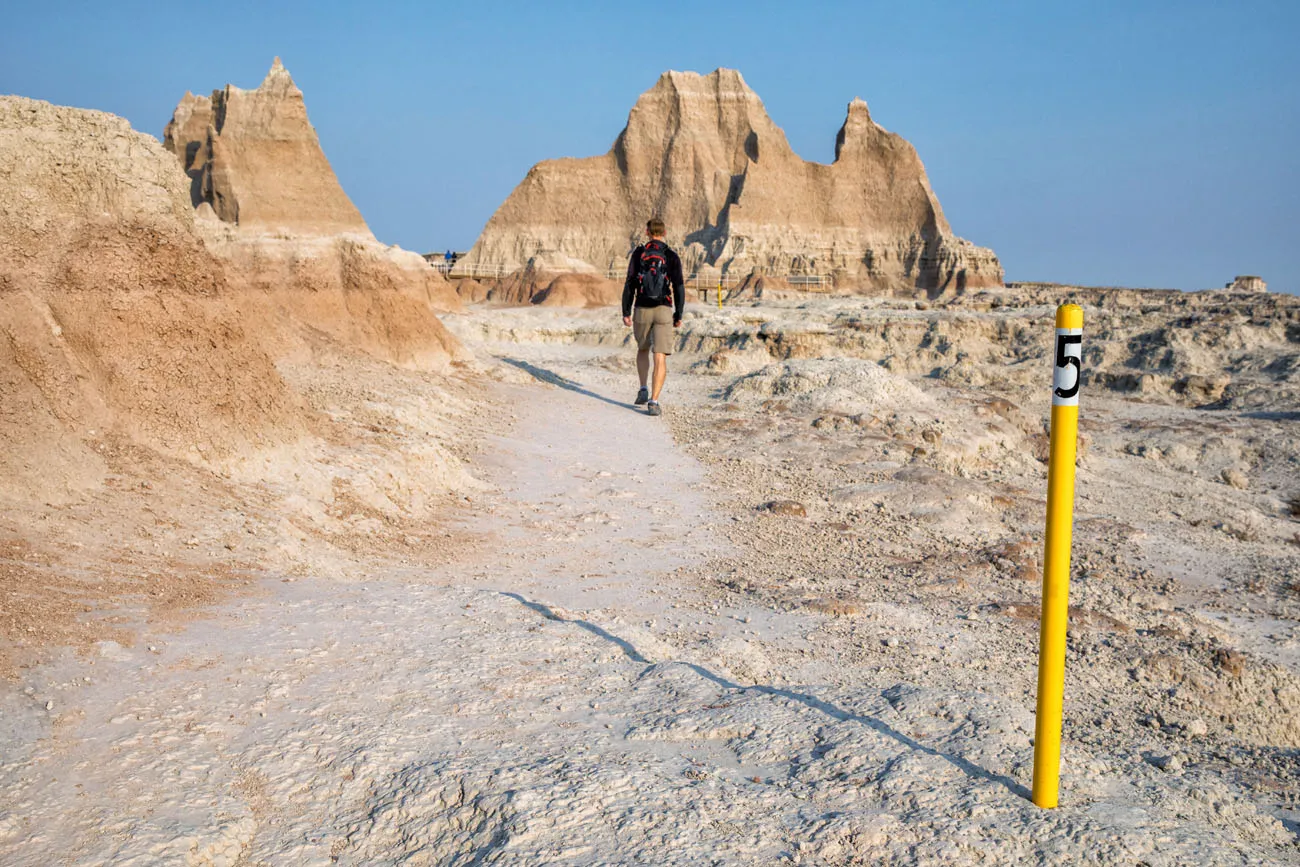
PRO TRAVEL TIP: The Notch Trail, Door Trail, and Window Trail all start from the same parking lot. The Castle Trail also starts here and heads west through the park, ending at the Fossil Exhibit Trail. This parking lot is enormous and there are restrooms here.
9. The Cliff Shelf Nature Trail
The Cliff Shelf Nature Trail is located near the base of the final viewpoint from the Notch Trail. This trail offers stunning views along “the Wall” and up to the Notch. It is 0.5 miles round trip with 300 feet of elevation gain and takes most people about 15 minutes.
Note: We were unable to do this on our visit because of road construction.

10. Drive Sage Creek Rim Road
Sage Creek Rim Road heads into the western section of Badlands National Park. This road is a well-maintained gravel road that is suitable for standard cars. If you want to visit a less-traveled part of the park, get up close with wildlife, see more of the prairie land, or head into the backcountry, it’s worth doing this short drive.
Sage Creek Rim Road starts on the Badlands Loop Drive, not far from the Pinnacles Overlook. It is 25 miles long, ending near Scenic, South Dakota. As you head farther west from the Pinnacles overlook, the pinnacles and spires gradually fade away, to be replaced with rounded hills and small forests of pine trees.
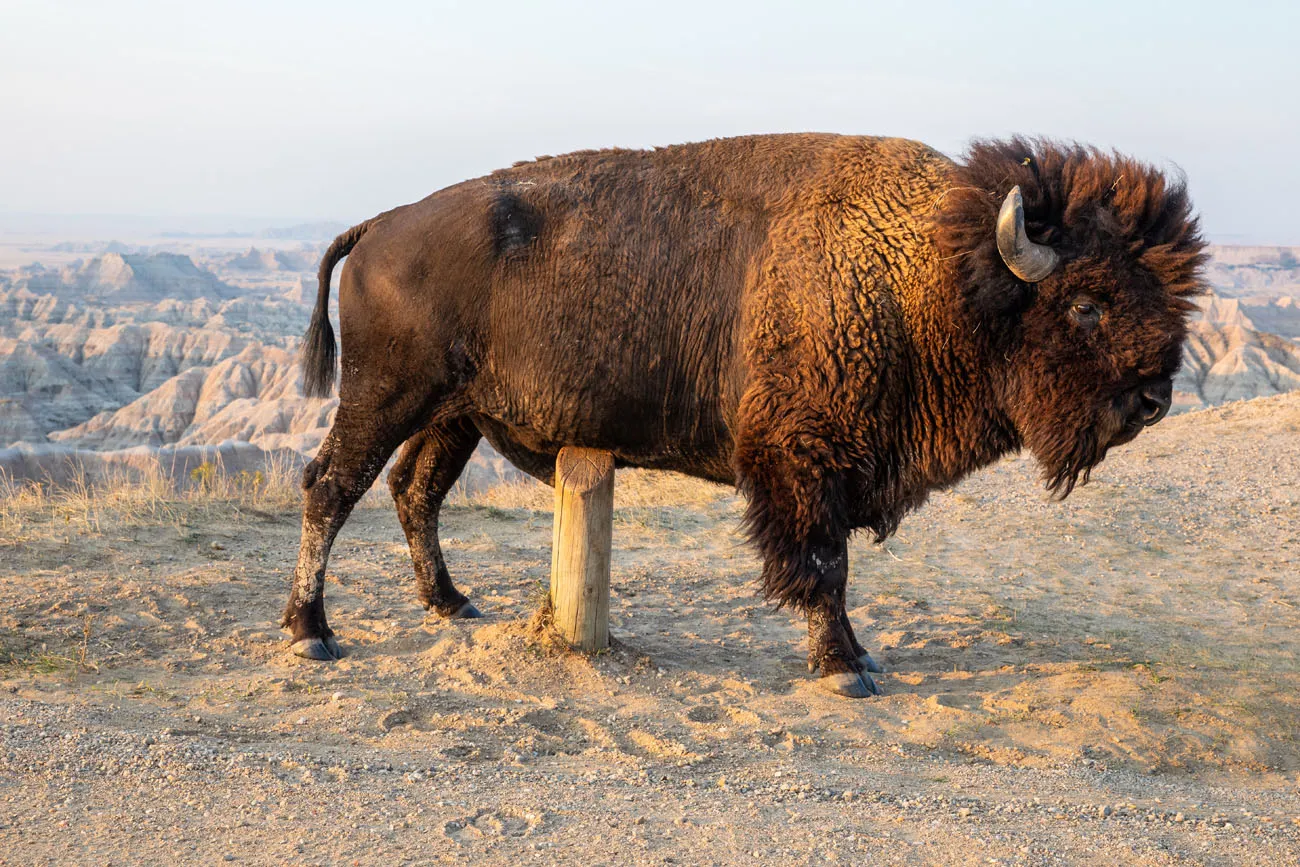
This area of the park feels more rugged, wild, and remote than the paved Badlands Loop Road. What it lacks in scenery it makes up for with wildlife sightings. On this road, and really not all that far from the Pinnacles overlook, we saw lots of bison, some pronghorn and bighorn sheep, and a coyote.
Here are the views from the overlooks along Sage Creek Rim Road.
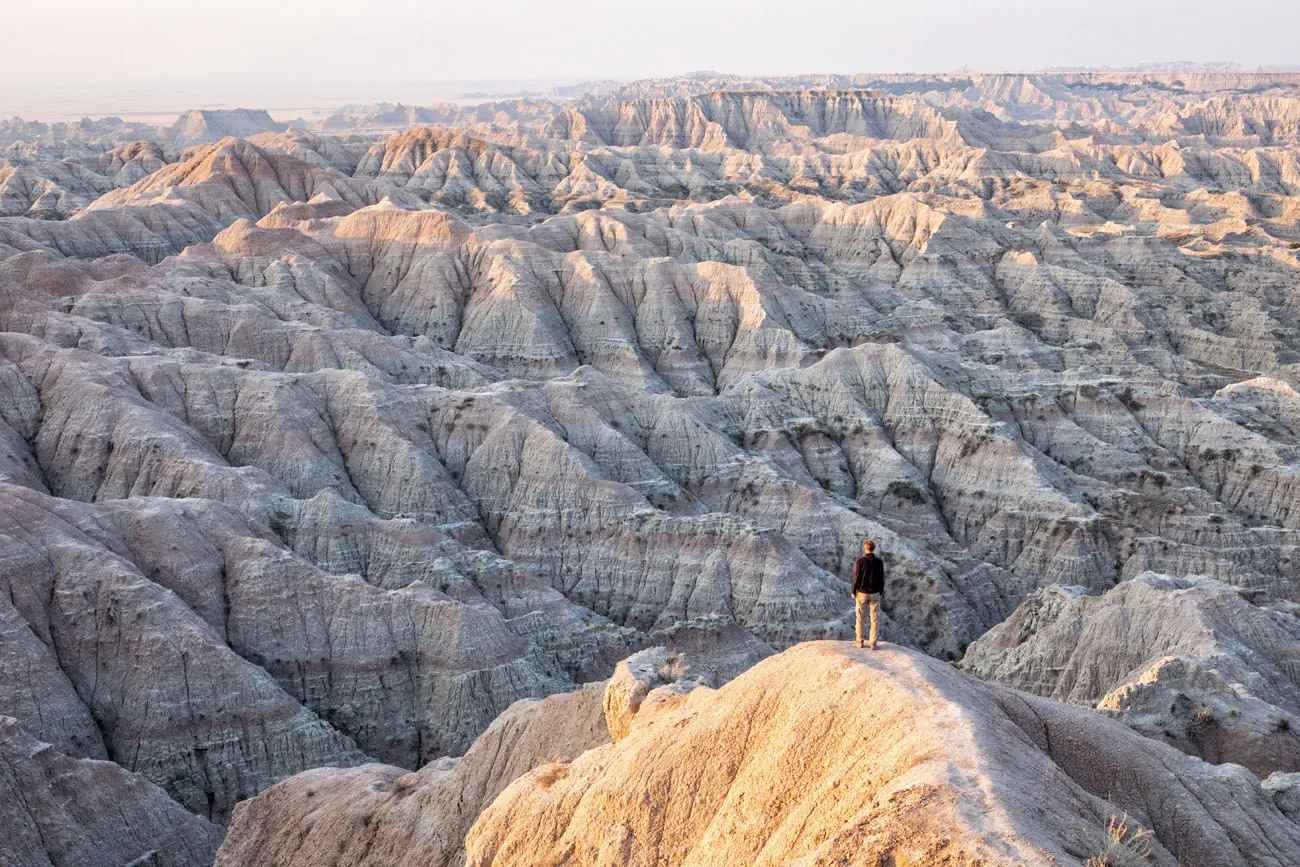
Hay Butte Overlook
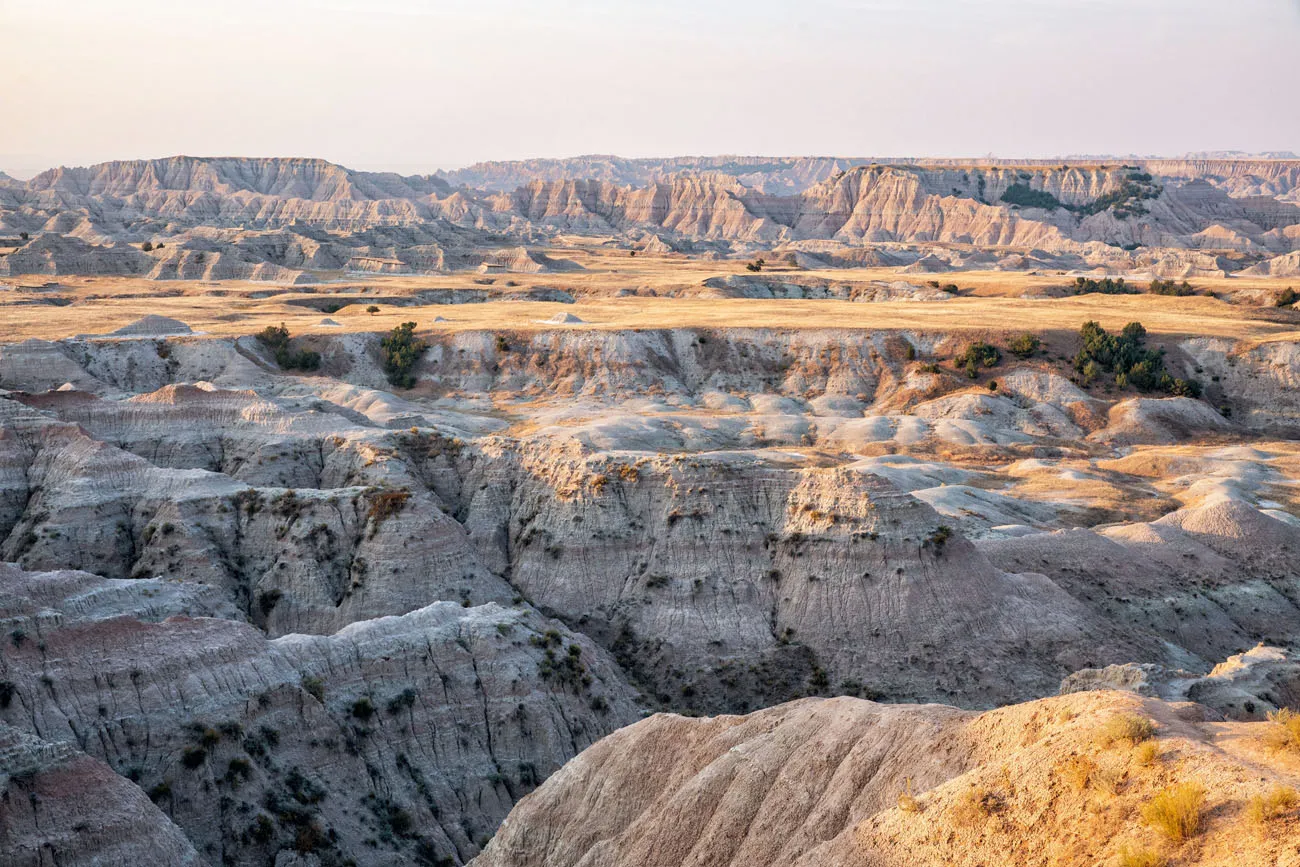
Badlands Wilderness Overlook
PRO TRAVEL TIP: You don’t have to drive the entire length of Sage Creek Rim Road. To get to Sage Creek Wilderness Overlook, it is a 6-mile drive, one-way (starting near the Pinnacles Overlook), past the best scenery on the road. With stops at the overlooks and at Roberts Prairie Dog Town, this drive will take about one hour.
11. Roberts Prairie Dog Town
Located on Sage Creek Rim Road is Roberts Prairie Dog Town. If you have never seen prairie dogs this is a great place to observe them.
Prairie dogs are ground squirrels. They form “towns,” which are collections of burrows and family units that can span many acres. The prairie dogs sit at the openings of their burrows and bark a warning cry to their buddies as invaders approach. If you get to close, the prairie dog will escape down into their burrow, emitting one final squeak.
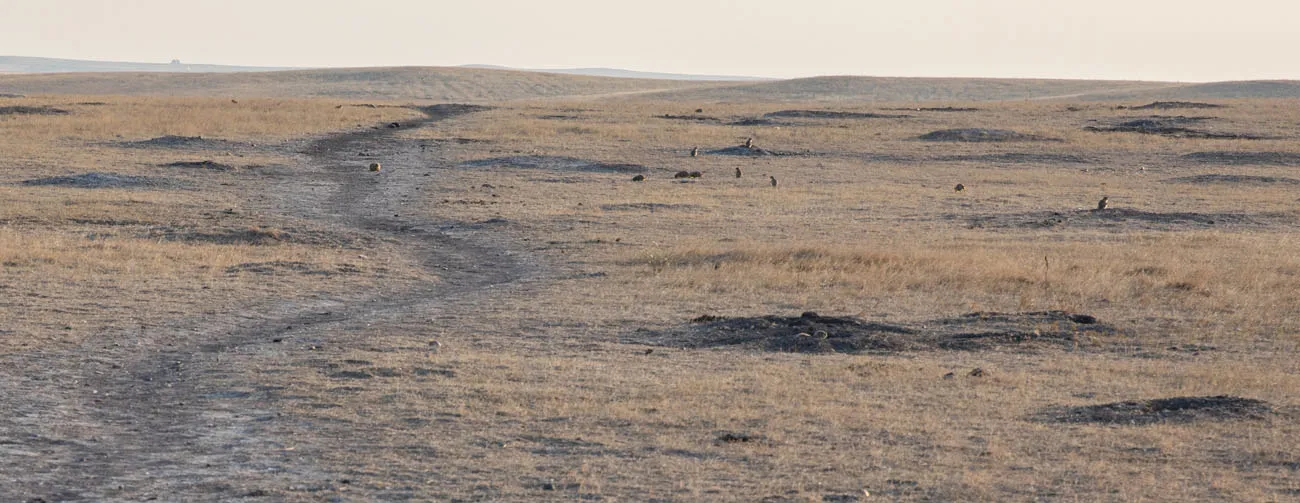
To see the prairie dogs at Roberts Prairie Dog Town, simply park your car in the car park and walk one of the trails out into the town.
Note: As part of Leave No Trace, do not feed the prairie dogs.
12. Hike the Sage Creek Wilderness Area
Explore the backcountry of the Badlands by hiking the Sage Creek Wilderness Area. The Badlands are one of the few national parks where visitors are permitted to hike off trail, exploring the wilderness on their own. There are no maintained trails here but you are permitted to hike the area on your own.
The Sage Creek Wilderness Area can be accessed from several points. The Sage Creek Campground is a popular access point but if you don’t want to drive that far down Sage Creek Rim Road, you can also start at the Sage Creek Basin Overlook. This is what we did.
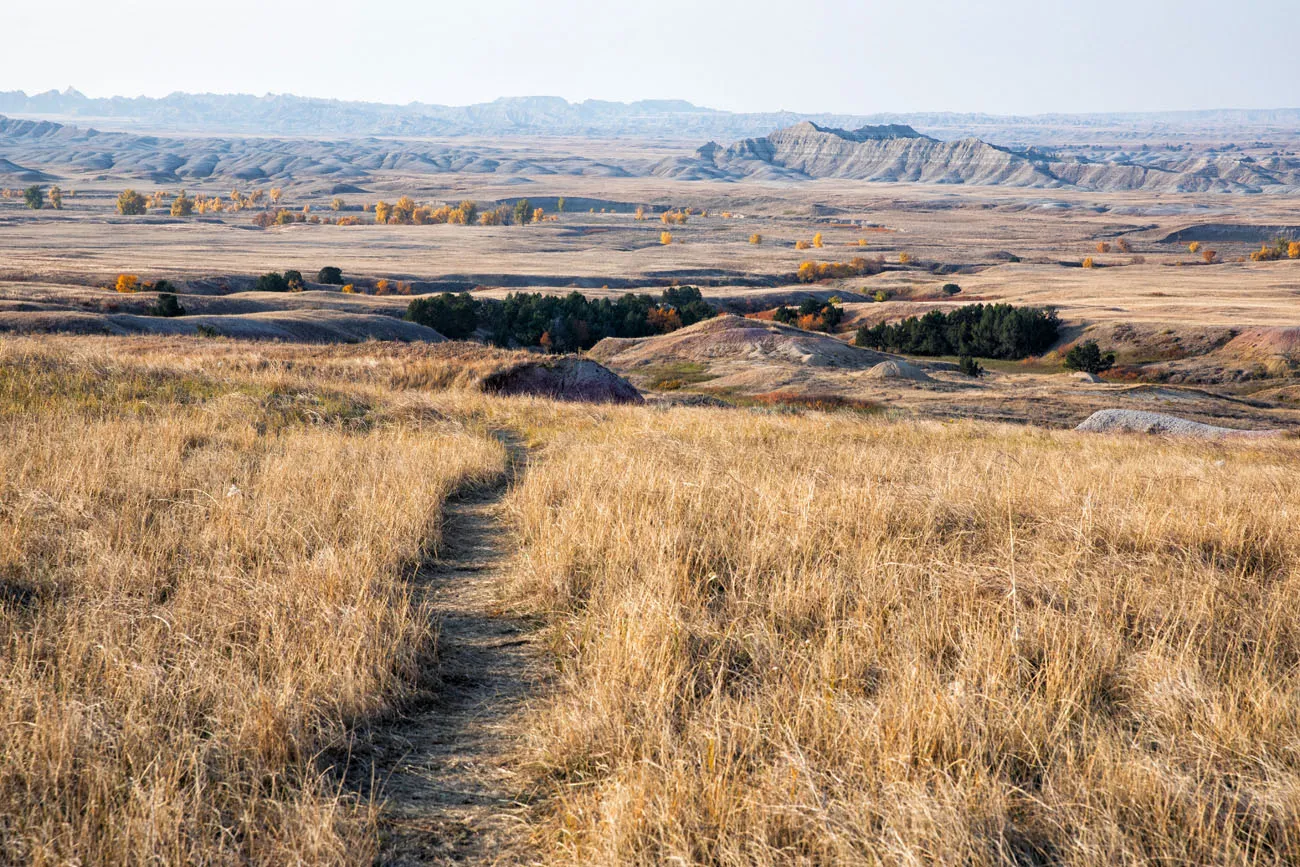
The view from Sage Creek Basin overlook.
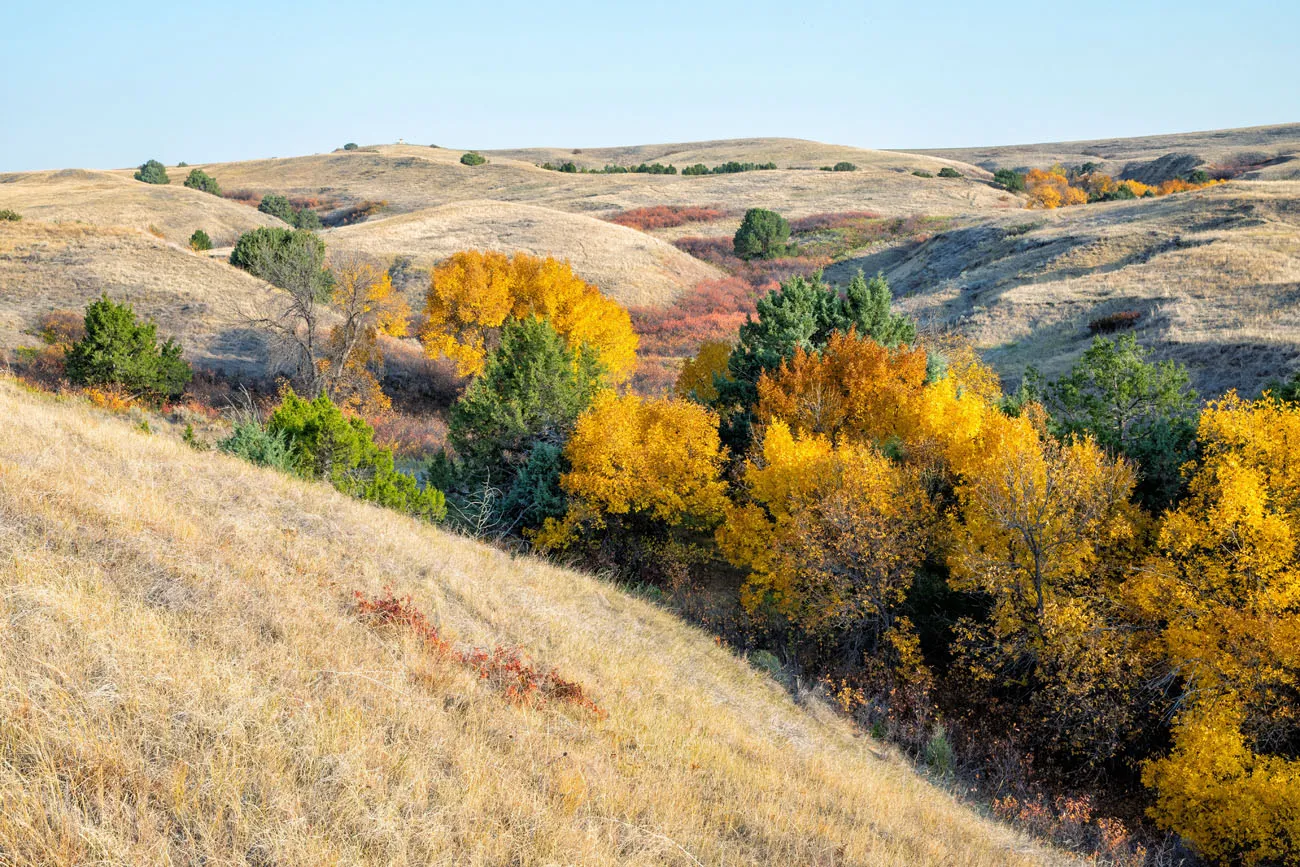
Before you go, register your name and vehicle information details in the Backcountry Register. From here, you can hike out into the Sage Creek wilderness, following the faint hiking trails and bison trails that weave their way through the tall grass. We saw bison grazing off in the distance, but the real thrill was just being out here on our own. Tim and I hiked just about a mile round trip, nothing too far or too time intensive, but it was still a very nice experience. But it would be very easy to wander through this wilderness all day.
In the Sage Creek Wilderness, you will hike through the grasslands with a good chance of spotting bison, bighorn sheep, and pronghorn. However, this area lacks the rugged, rocky scenery that makes the Badlands so photogenic. But if you want to escape the crowds, this is a good place to do it.
13. Hike the Deer Haven Wilderness Area
Similar to the Sage Creek Wilderness Area, the Deer Haven Wilderness area is another area of the Badlands where you can hike unmaintained trails into the backcountry.
The hike to Deer Haven starts at the Conata Picnic Area. Drive the road to the very end and park in the parking lot. Fill out the Backcountry Register before starting your hike.
If you follow the trail for 3 miles, you will reach Deer Haven, where you have great views of the park and an excellent chance to spot wildlife.
We did not go that far. Instead, about a half mile into the hike, we took a faint side trail and followed it into the Badlands. For much of the time, we hiked through a wash as the striped walls and rock formations grew up around us. It was tons of fun and the real enjoyment is just being out here, exploring on your own.
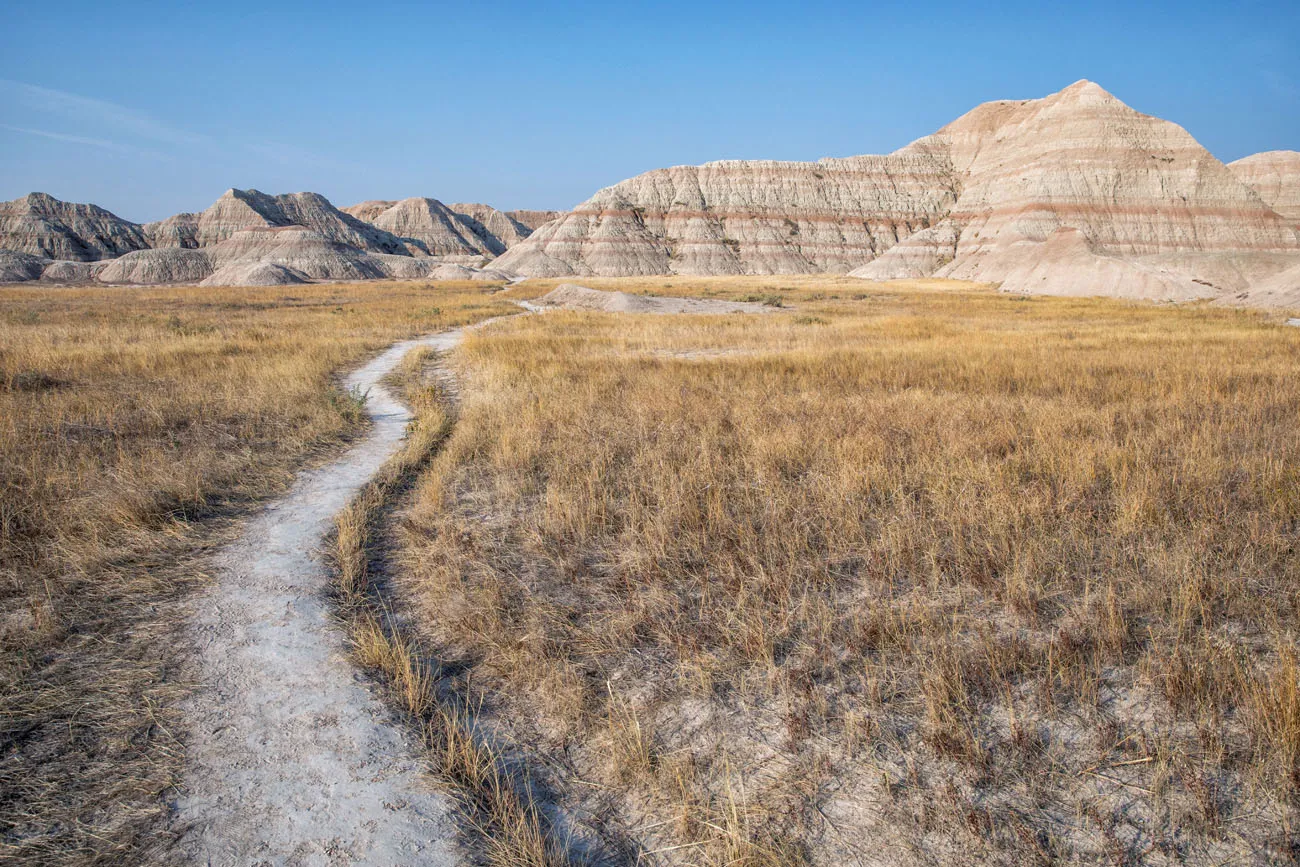
PRO TRAVEL TIP: Even though the trail is unmaintained, it was very easy to follow. However, we were only on the main trail for a half mile before following a different trail into the Badlands. I recommend taking photos of the trail as you hike, just to make sure you know how to get back to your car. We also hike with a Garmin GPS and Garmin Fenix watches, which track our route. If we ever get lost, we can follow our route back to our starting point.
14. Sheep Mountain Overlook
Sheep Mountain Road is a gravel road takes you through a more remote section of Badlands National Park. This road starts in the North Unit and ends in the South Unit.
Sheep Mountain Road starts off as a well-maintained gravel road. It travels through badlands scenery, similar to what you see along the Badlands Loop Road. It climbs a small hill, taking you to a spectacular overlook.
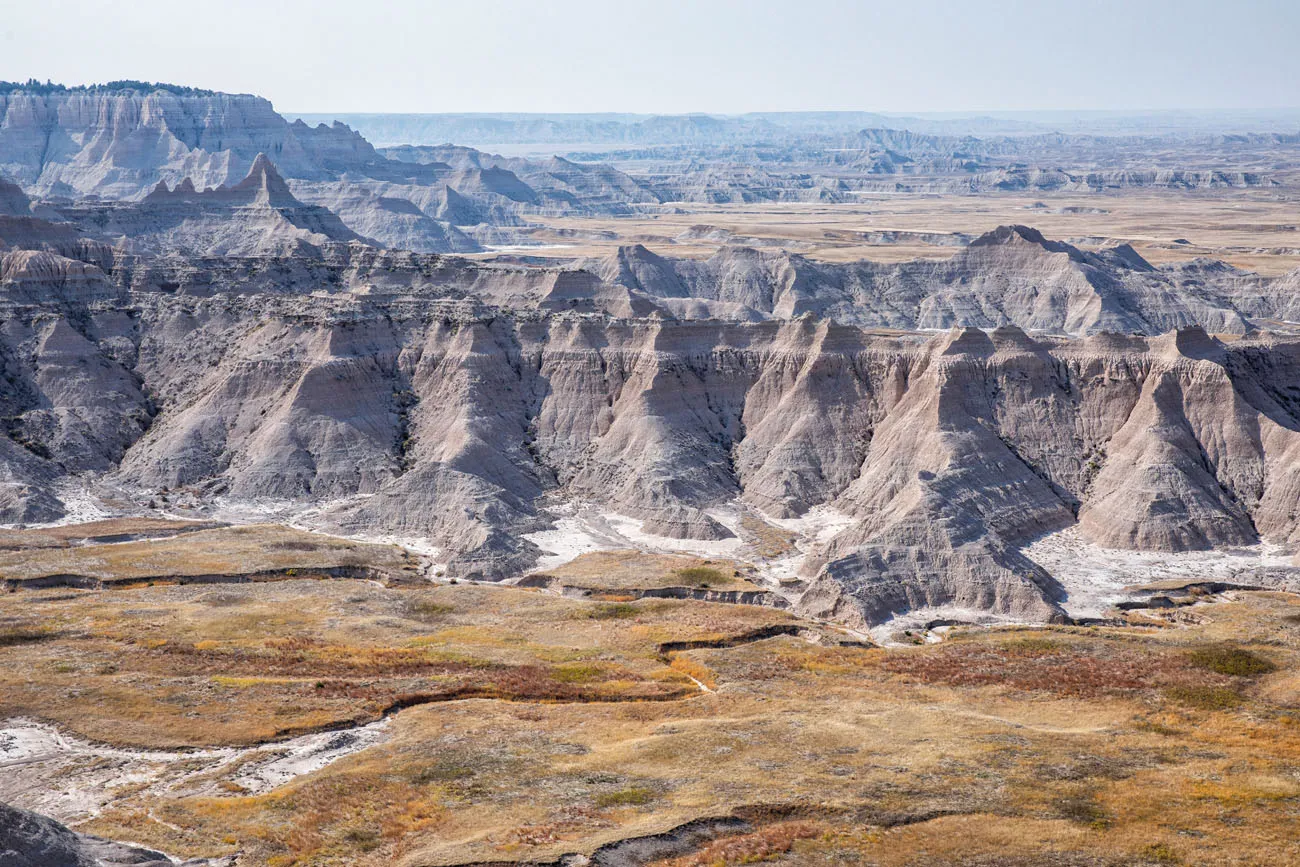
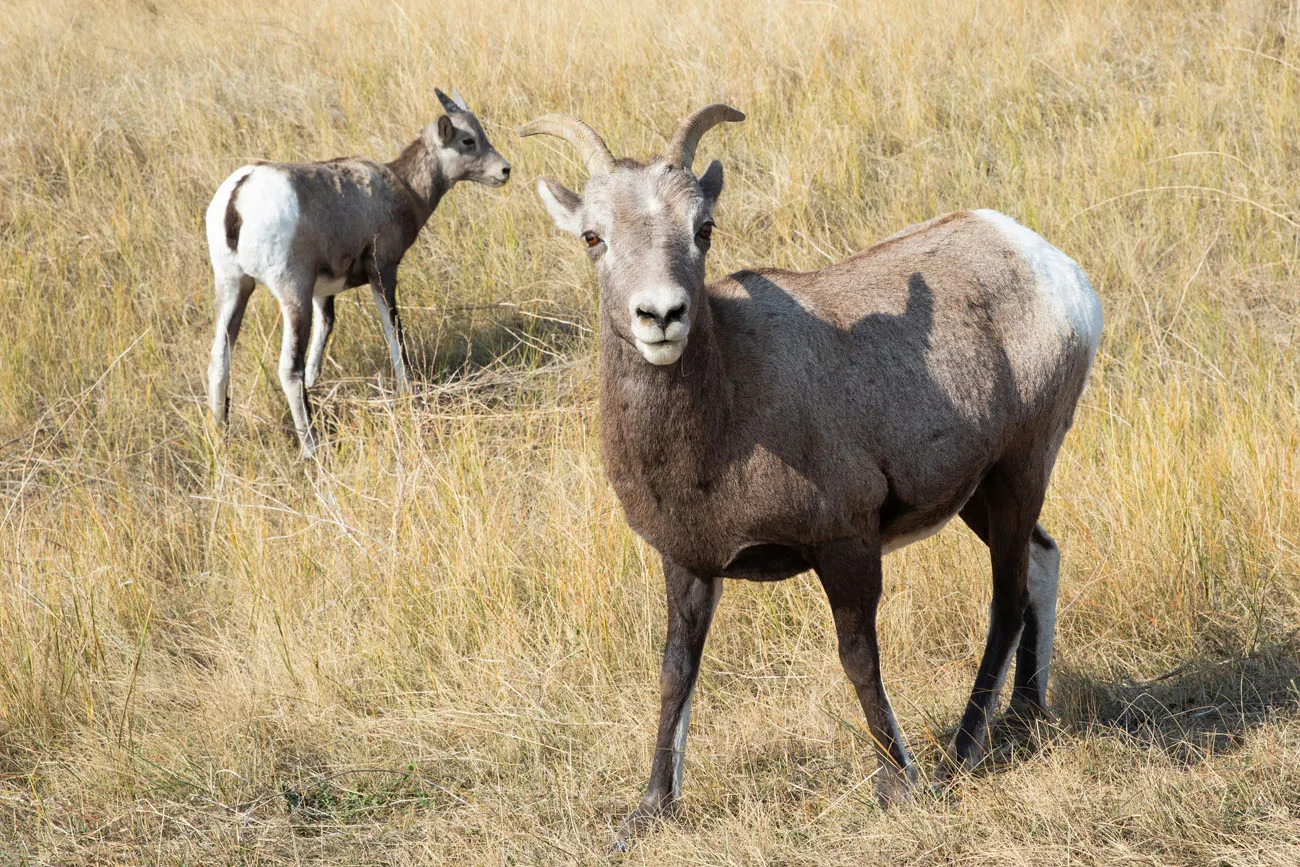
Beyond the Sheep Mountain Overlook, the road enters the South Unit and becomes much rougher. To keep going, you must have a vehicle with good ground clearance and a 4×4 is recommended. Standard cars and small SUV’s will not make it down this road.
Unfortunately, I do not have photos of what is at the end of Sheep Mountain Road, for two reasons. We were in a small SUV and attempted to drive further, but turned around almost immediately due to the rough conditions of the road. Secondly, the South Unit was closed during our visit due to COVID-19 so had we made it farther, we would have been forced to turn around once we reached this boundary.
Getting Here: Take Bombing Range Road south from Scenic for 4 miles and turn right onto Sheep Mountain Road. It is a 4.8 mile drive to get to the overlook.
15. Red Shirt Table Overlook
Red Shirt Table Overlook is the best place to get a view of the South Unit of Badlands National Park. Unfortunately, this was closed during our visit.
Red Shirt Overlook is located on Highway 41 on the west side of the South Unit.
Three More Places to Recommend
Just outside of the park are three more notable places to recommend. These are not located on national park land but they make nice additions to your trip.
Scenic, South Dakota
Scenic is a “ghost town” that is located just outside of national park lands. In 2010, 58 people lived here. The town and the surrounding area were purchased in 2011 by Iglesia ni Cristo, a Christian church in the Philippines. Not much has been done with the town since this time and now it’s just a collection of abandoned buildings. It’s worth a quick visit if you plan to visit Sheep Table Overlook, Red Shirt Table Overlook, or the South Unit of Badlands National Park.
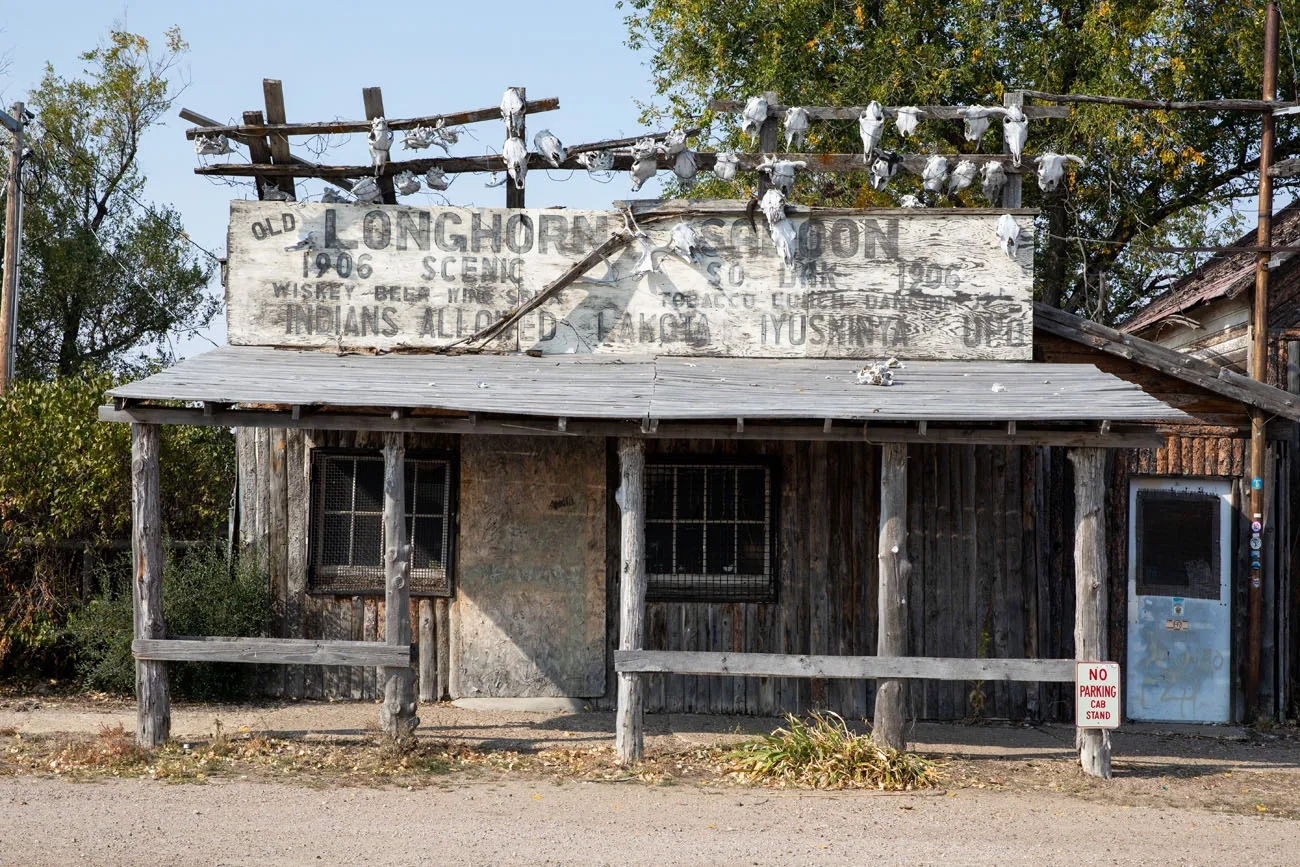
Minuteman Missile National Historic Site
During the Cold War, hundreds of Minuteman Missiles were hidden in silos near the Badlands. Now, the national park service preserves two of these sites, the the Launch Control Facility for Delta-01 and the Delta-09 Missile Silo.
Start your visit at the Minuteman Missile Visitor Center, which is located near the east entrance into the Badlands. There is a small museum here and it is filled with lots of interesting facts about the Cold War and the accumulation of missiles by the United States and the Soviet Union.
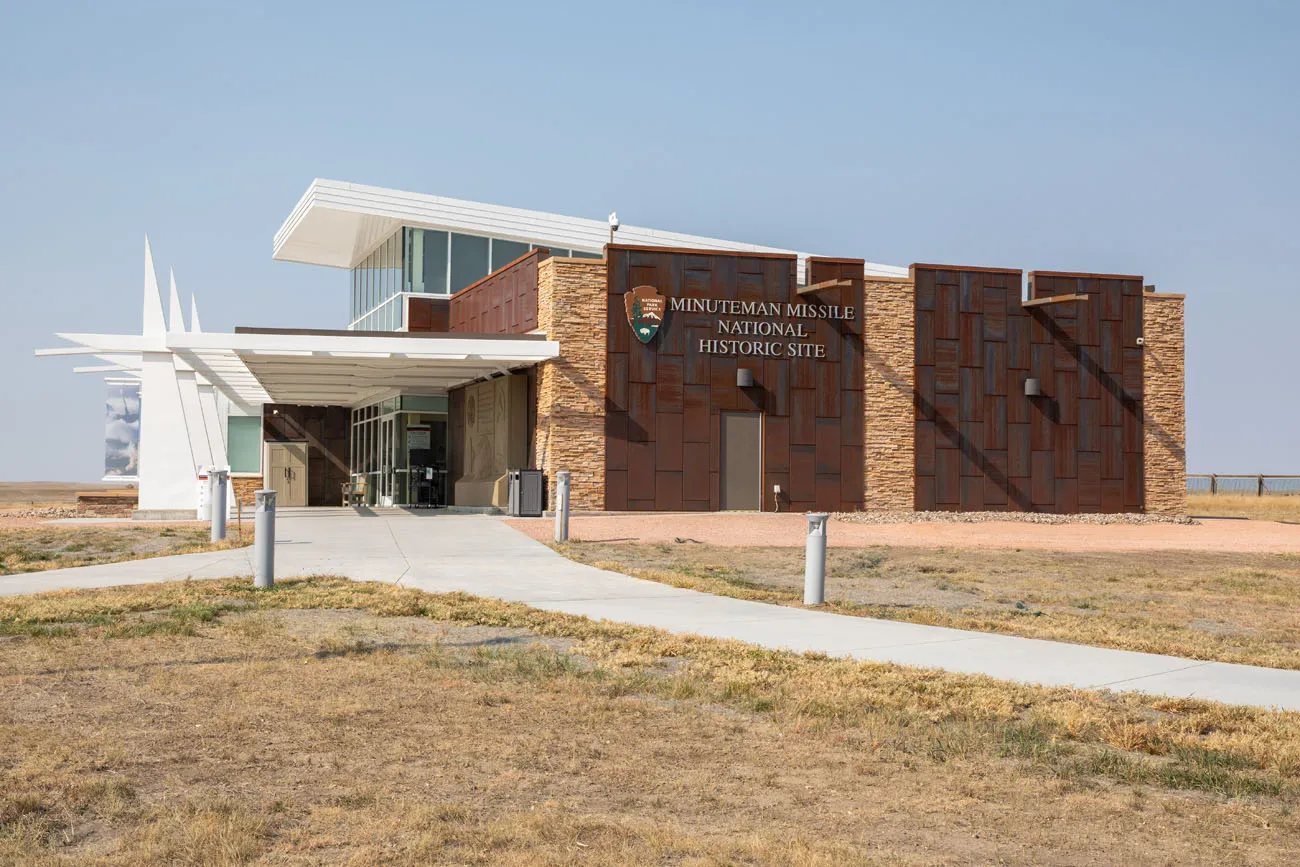
You can also look down into the Delta-09 Missile Silo (no tour necessary), which is located 15 miles northwest of the Visitor Center, just off of Highway 90 (7 miles from Wall).
If you want to tour the Launch Control Facility, you can only do this on a guided tour.
Get the full details on hours of operation and tours of the Launch Control Facility here.
Wall Drug
If you are driving through South Dakota, or even in a neighboring state (we saw signs for Wall Drug near Devils Tower!!), you will see a crazy number of billboards for this drugstore.
Wall Drug started in 1931 as a small drug store in a very small town. Through self-promotion, Wall Drug grew into a cowboy-themed mall. Now, it has several restaurants, shops, and art gallery, and even a small chapel.
According to the New York Times, Wall Drug is “a sprawling tourist attraction of international renown that draws some two million annual visitors to a remote town.” That’s quite impressive, considering that Badlands National Park only gets 1 million visitors per year.
If you are taking a midday break or just need a bite to eat, it’s a short drive to Wall Drug from Badlands National Park.
How Much Time Do You Need in the Badlands?
With half of a day, you can drive Badlands Loop Road, visit several of the overlooks, and hike a short trail (we recommend the Notch Trail, the Door Trail, or hiking up Saddle Pass to the Castle Trail). Ideally, try to catch sunrise or sunset here, because they are magical.
With one day in Badlands National Park, you can do most of what we have on this list. Start on the east side of the park. Watch sunrise from Big Badlands Overlook. Hike the Notch, Door and Window Trails. Then, drive Badlands Loop Road, stopping at the visitor center and overlooks along the way. Walk the Fossil Exhibit Trail and continue west through the park. In the afternoon, drive Sage Creek Rim Road until you get to Sage Creek Wilderness overlook. Return to the Pinnacles Overlook for sunset. Get the full itinerary in our article One Perfect Day in Badlands National Park.
With two days in Badlands National Park, you can do everything on this list. Follow our one day itinerary above, but instead of driving Sage Creek Road, hike part or all of the Castle Trail. On day 2, watch the sunrise from the Pinnacles Overlook. Venture out into the backcountry and hike Sage Creek Wilderness or Deer Haven. Drive Sage Creek Road and then visit Scenic, Sheep Mountain Overlook, and the South Unit of Badlands National Park.
Interesting Facts About Badlands National Park
Badlands officially became a national park on November 10, 1978. In 2022, it received 1 million visitors, making it the 26th most visited national park that year.
Badlands National Park gets its name from the Lakota people, Native Americans who inhabited this land. The Lakota people called this land “mako sica” which translates to “bad lands.”
Why is this land called “badlands?” Summers are hot and dry. Winters are cold and windy. There is very little drinking water and the land is hard to travel through. It makes a great place to visit (especially from an air-conditioned car) but this is not the kind of place that many would like to call home.
The term “badlands” also indicates a type of terrain where clay-rich soils have been eroded by wind and water. In the United States, you can also see “badlands” in Death Valley, Petrified Forest, and Theodore Roosevelt National Parks.
There are two sections to Badlands National Park. The North Unit is the most visited part of the park. This is where you will find the Badlands Loop Road, Sage Creek Wilderness Drive, and the top hikes and overlooks in the park.
The South Unit, also called the Stronghold Unit, is co-managed by the Oglala Lakota Tribe. The South Unit was a former Air Force bomb range during World War II. We were warned by a park ranger not to go hiking in this section of the park since there are still unexploded bombs here.
For thousands of years, Native Americans used this land as hunting grounds. At the end of the 19th century, homesteaders moved into this territory and the Native Americans were forced off of the land. The Great Dust Bowl of the 1930’s forced many of these settlers off of the land. Later, during WWII, the US Air Force took possession of the land to be used as a bombing and gunnery range. In recent years, Badlands National Park has been taking steps to return the South Unit to the management of the Oglala Lakota Sioux tribe.
For more information about the history and culture of Badlands National Park, click here.
This park preserves 244,000 acres and contains the largest mixed-grass prairie in the United States. Bison, bighorn sheep, and pronghorn are frequently seen here, as are prairie dogs. The black-footed ferret, one of the most endangered mammals in the world, was reintroduced into this park.
Nomadland, Dances with Wolves, Armageddon, Thunderheart, and Starship Troopers were filmed in this park.
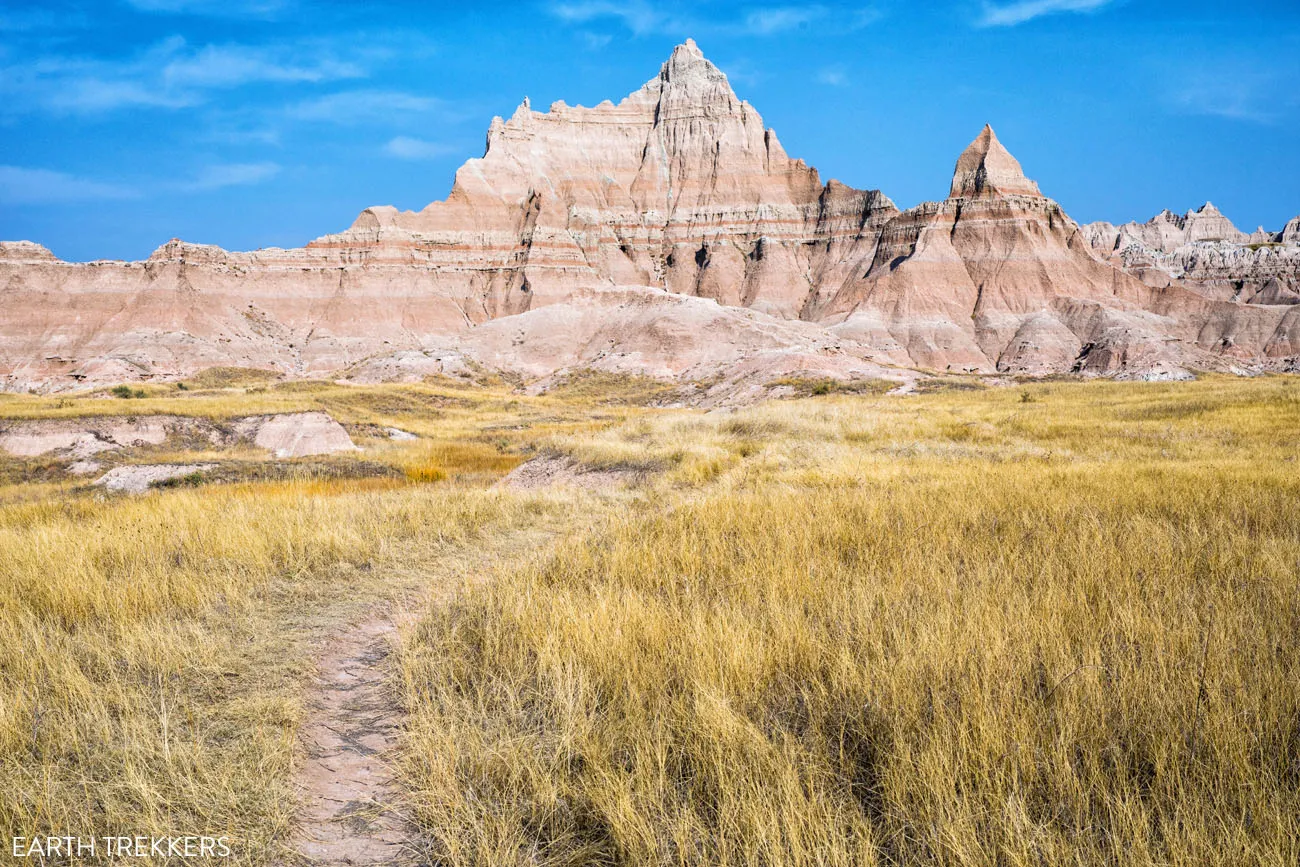
Best Time to Visit Badlands National Park
The best time to visit Badlands National Park during the spring and fall months.
Spring is a nice time to visit the park, with cool temperatures and low crowds. As the warmer weather moves in, rain chances increase. June is the wettest month in the park. If you don’t mind the chance of rain, May is a beautiful time to visit the park.
In summer, temperatures can soar well past 100°F. Violent thunderstorms with hail can spring up with little warning and tornadoes are a possibility.
The fall months are a spectacular time to visit the Badlands. Temperatures are cool, rainfall is low, and crowds begin to lessen once kids return to school. We visited the Badlands in early October and had a great experience. We were here during a heatwave and it did get up to 89°F one day, but the mornings and evenings were cool and clear. Typically, the high temperature in October is 65°F.
Winters are cold and windy. Snowfall is very likely and the Badlands typically get 12 to 24 inches of snow per year.
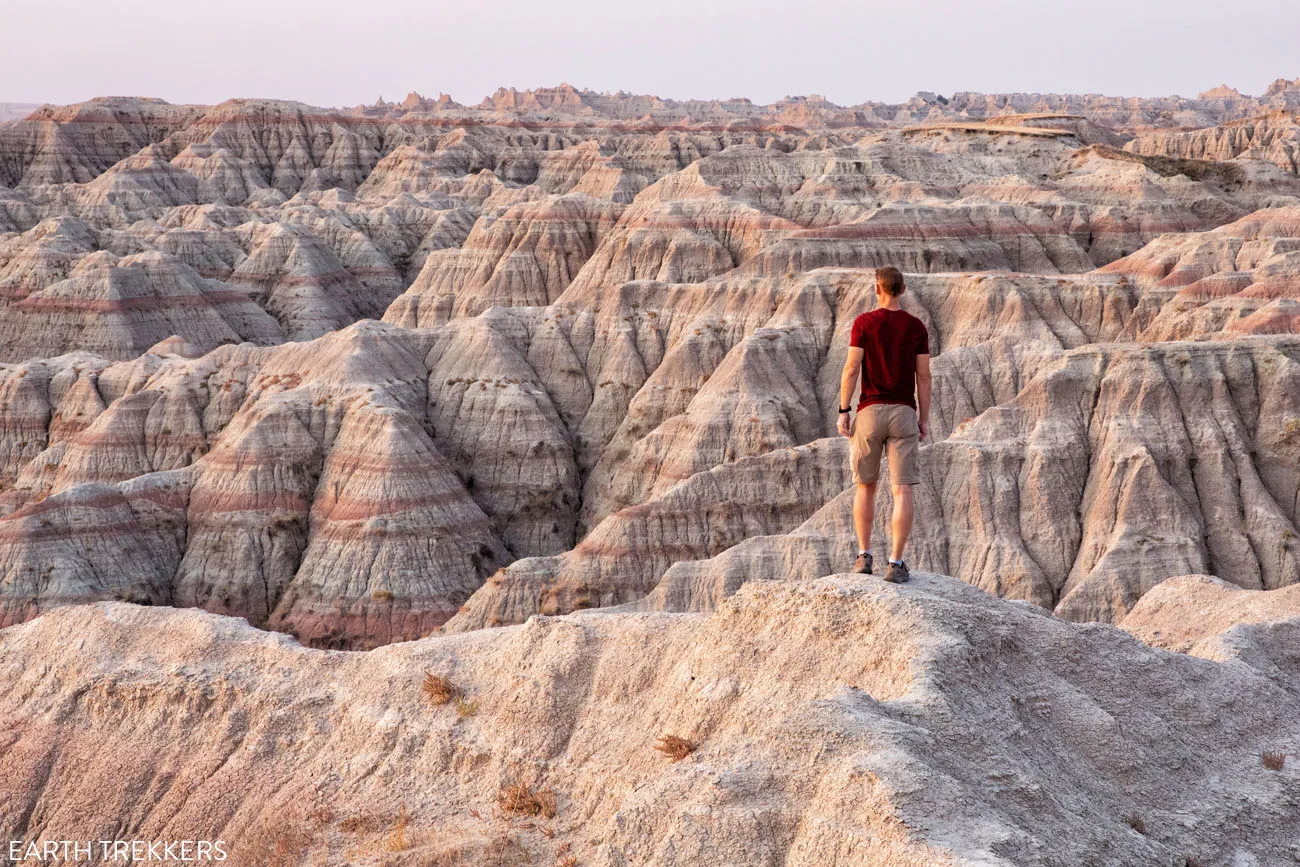
Big Badlands Overlook
How to Get Here
The closest airport is in Rapid City, South Dakota. From the airport, it takes one hour to drive to the park.
Here are the driving distances and times from nearby destinations:
Wall, South Dakota: 8 miles, 15 minutes
Rapid City, South Dakota: 62 miles, 1 hour
Wind Cave National Park: 55 miles, 1.25 hours
Devils Tower, Wyoming: 165 miles, 2.5 hours
Sioux Falls, South Dakota: 276 miles, 4 hours
Denver, Colorado: 375 miles, 6 hours
Where to Stay
In Badlands National Park
If you want to stay in the park, you have a few options. The only lodge in the park is the Cedar Pass Lodge. There are also two campgrounds in the park. The Cedar Pass Campground has some sites for RV’s but the Sage Creek Campground does not. Backcountry camping is permitted in Badlands National Park. Learn more on the official website.
Outside of the Park
The closest town is Wall. To get into the park it is just a 15 minute drive. I recommend staying here, rather than driving back and forth to Rapid City, especially if you plan to spend more than one day here.
Wall is a very small town, with a handful of hotels and motels and a few decent restaurants.
We stayed at the Best Western Plains Motel, which is one of the highest rated properties in town. Rooms are nothing fancy but they are clean and quiet and the WiFi was decent. America’s Best Value Inn and the Days Inn get mediocre reviews.
In Wall, you can have lunch at Wall Drug (they close at 6 pm so don’t expect to get dinner here). We ate at Badlands Saloon and Grille twice for dinner and enjoyed it. Amigo’s Cantina was recommended to us by our hotel staff.
Tips to Have the Best Experience
The only restaurant in the park is the Cedar Pass Lodge, located near the Ben Reifel Visitor Center. Other than this, there are no other food options inside the park, so pack a picnic lunch for the day (especially if you only have one day in the park). It will take a minimum of 30 minutes to drive back and forth to Wall. This isn’t a bad option, as it will give you a break from sightseeing, the crowds, and the midday heat, but just be aware of how much time you will lose by driving here.
Most of the larger trailheads have restrooms (the Visitor Center, Fossil Exhibit Trail, and Door/Window/Notch Trailhead have restrooms). I don’t recall seeing any restrooms at the overlooks on Badlands Loop Road.
Recommended camera gear: All of our photos were taken with a Canon 5D Mark IV camera with a 24-70 mm lens. I recommend bringing a wide angle lens to capture the amazing landscapes and a good zoom lens when photographing the wildlife.
Plan Your Visit
Entrance Fee: $30 per vehicle, valid for 7 days.
Hours: The park is open 24 hours, 7 days a week, 365 days per year.
Cellular Service: We had a decent cellular signal on Badlands Loop Road. It was enough to send texts and use Google for directions. But I wouldn’t expect to text your friends big video files or surf the internet while you are here. Public WiFi is available at the Ben Reifel Visitor Center.
Current Conditions: Get updated conditions in Badlands National Park as you plan your trip and before your visit on the official National Park Service website.
Frequently Asked Questions
What is the best trail to hike in the Badlands?
The Notch Trail is our favorite trail in the Badlands, since it is short, it’s fun from start to finish, and you get to climb the ladder made of logs. Hiking the Saddle Pass Trail to the Castle Trail is another great hike in the Badlands, as is hiking into the backcountry from Sage Creek Rim Road.
Is Badlands National Park worth it?
Absolutely. Badlands is highly underrated and one of our favorite national parks in the USA. Its small size, stunning landscapes, wildlife, short but sweet hiking trails, and spectacular sunsets make this an easy and very memorable national park to visit.
How many days should I spend in Badlands National Park?
With one busy day, you can drive through the heart of the park, visiting numerous overlooks, and hike a few short trails. Try to see sunrise or sunset, since the Badlands are gorgeous at these times of day. With more time, you can venture into the backcountry (worth it and very easy to do!), do more hikes, or explore the off the beaten path sights around the park.
When is the best time of year to visit the Badlands?
Spring and fall are the best times to visit Badlands National Park, when the weather is mild and crowds are relatively low. Badlands National Park appears in our Best US National Parks in April and Best National Parks in October articles. For more information about the best times to visit the national parks, check out our Best National Parks Month-by-Month Guide.
South Dakota Road Trip
With one week in South Dakota, you can visit Badlands National Park, the Black Hills, Mount Rushmore, Custer State Park, Wind Cave National Park, and day trip to Devils Tower.
To help you plan your trip, we have a One Week in South Dakota itinerary eBook that includes this itinerary, information about planning your time in Badlands National Park, and detailed daily schedules, insider tips, and travel planning resources. It is a 25-page version of our South Dakota Itinerary that you can download to take with you or print at home.
Click here to purchase the eBook on Etsy.com.
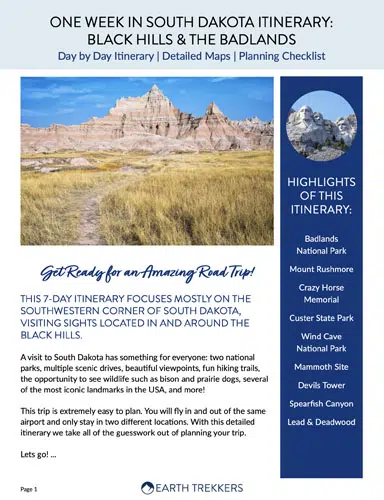
If you have any questions about the best things to do in Badlands National Park, let us know in the comment section below.
More Badlands & South Dakota Travel Guides
If you are visiting Badlands National Park as a bigger road trip through South Dakota, here is more information to help you plan your trip. Read all of our articles about the USA in our United States Travel Guide.
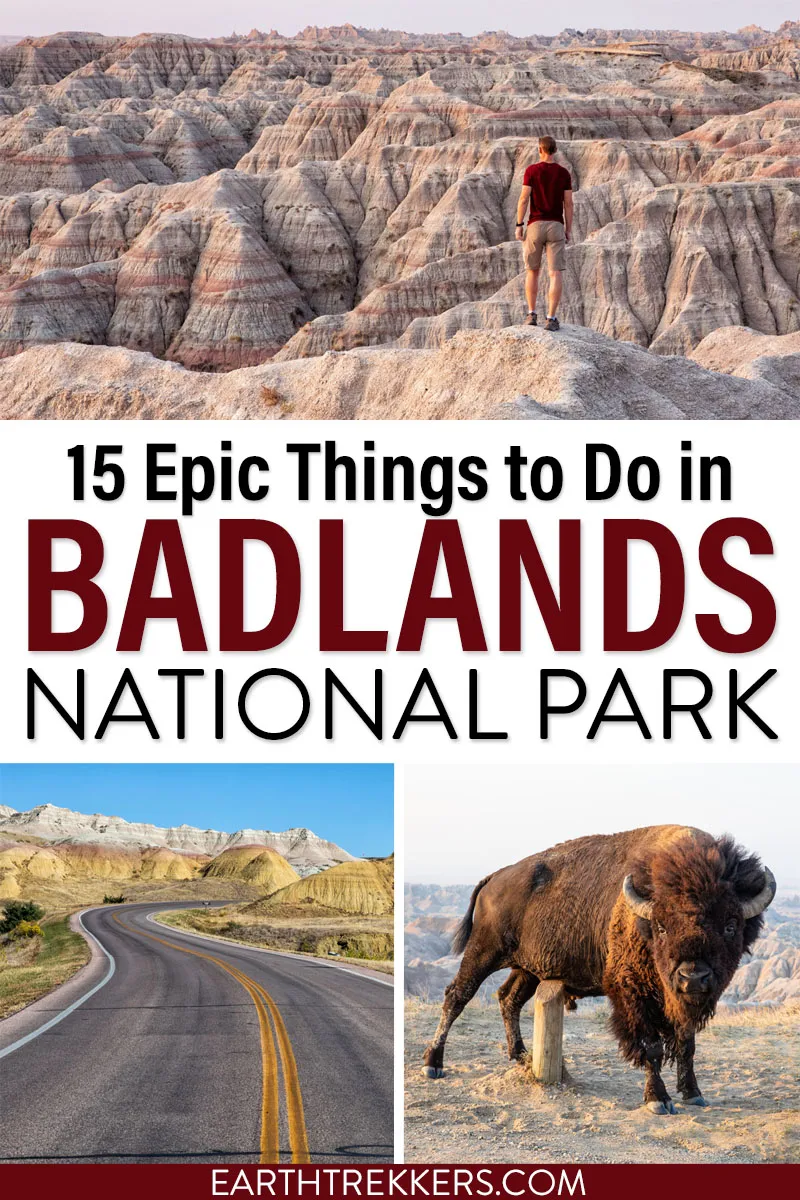
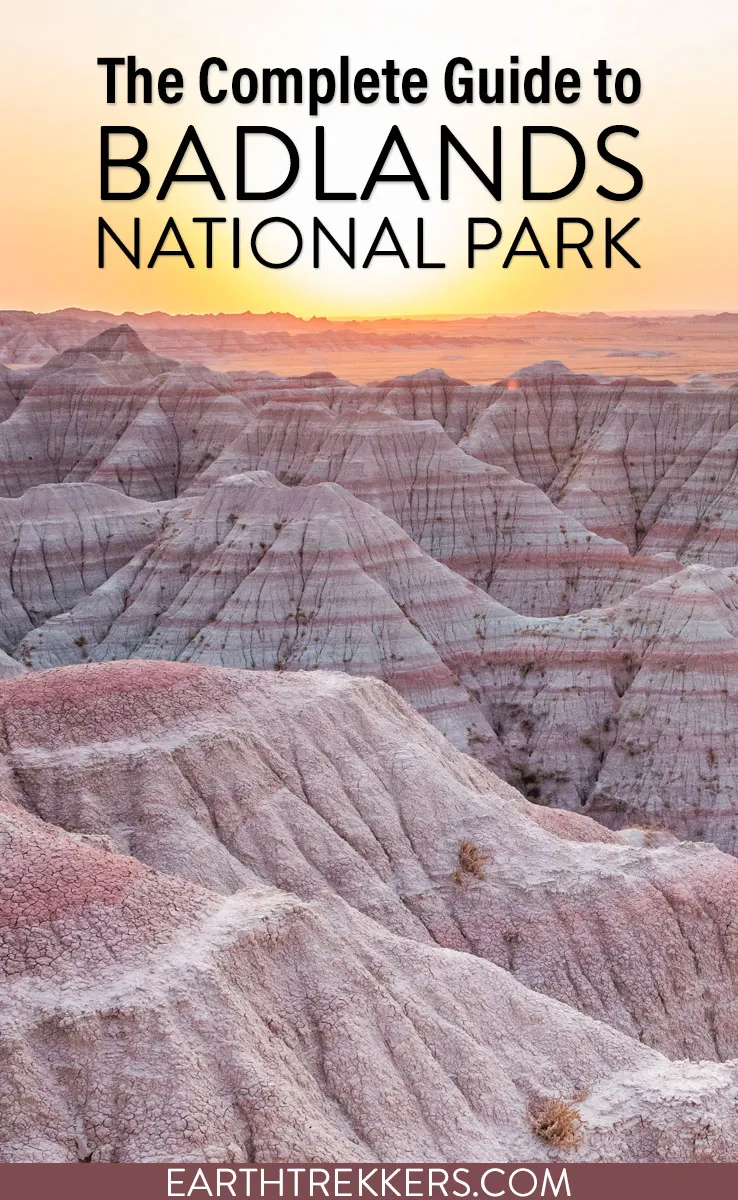
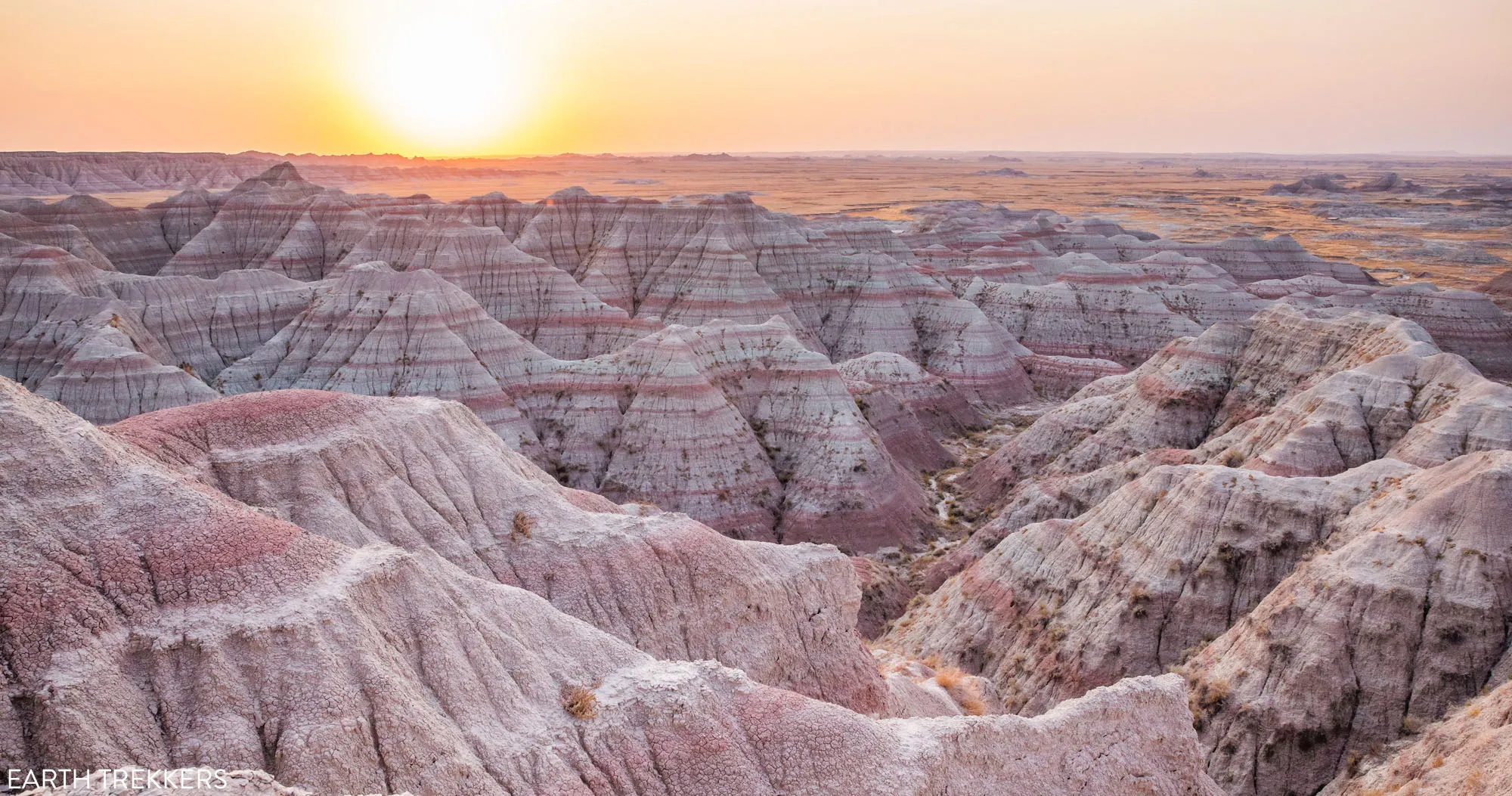
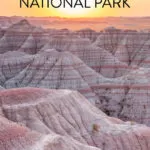
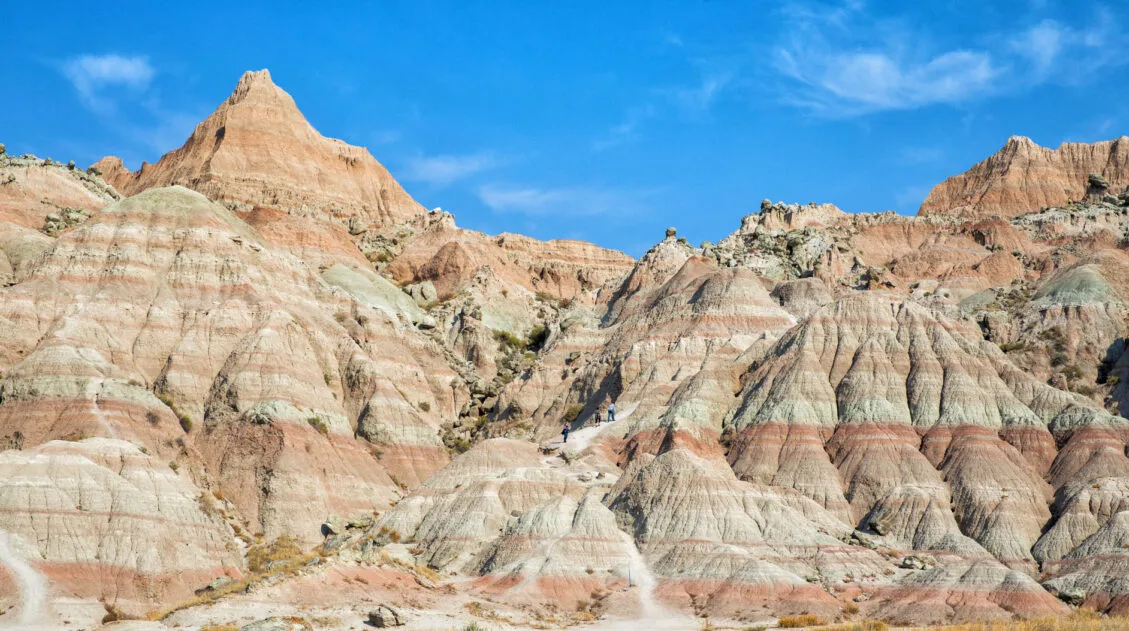
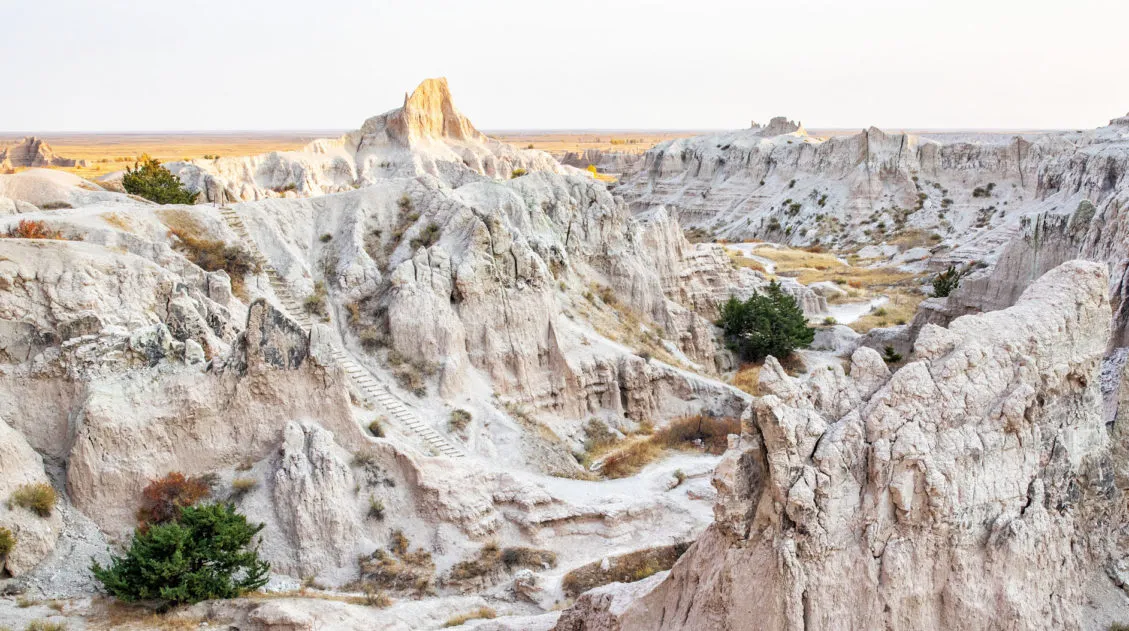
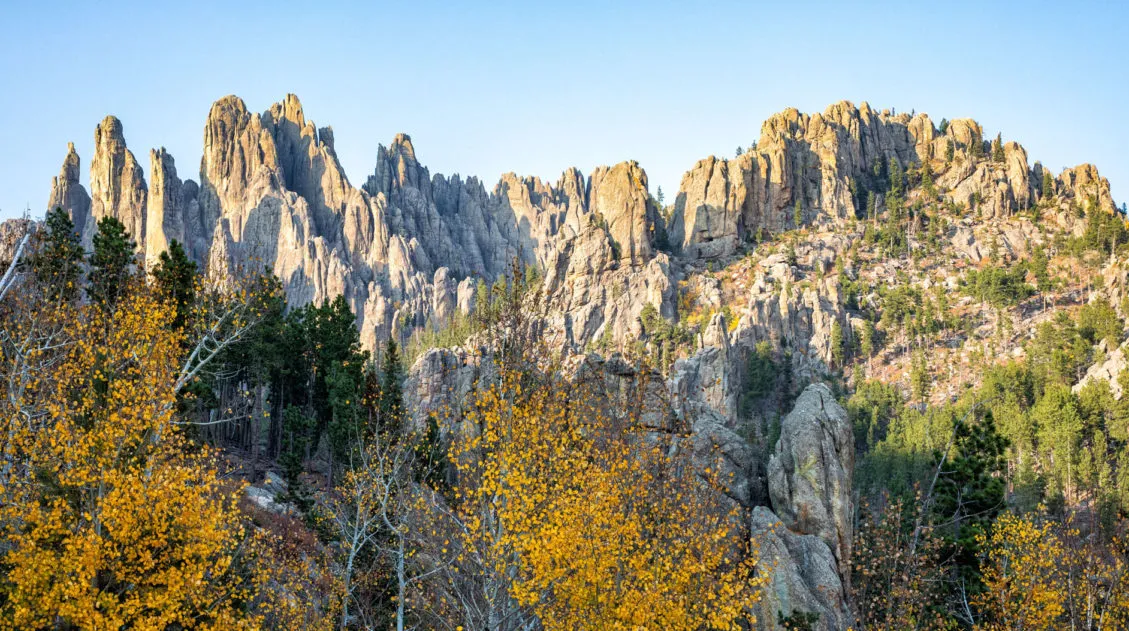
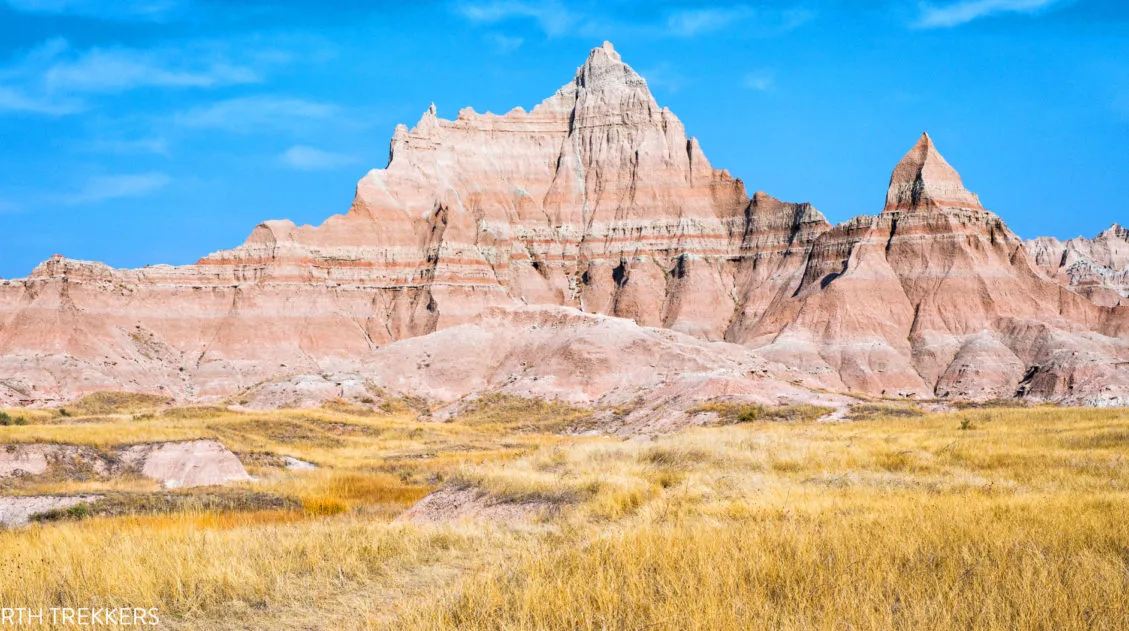
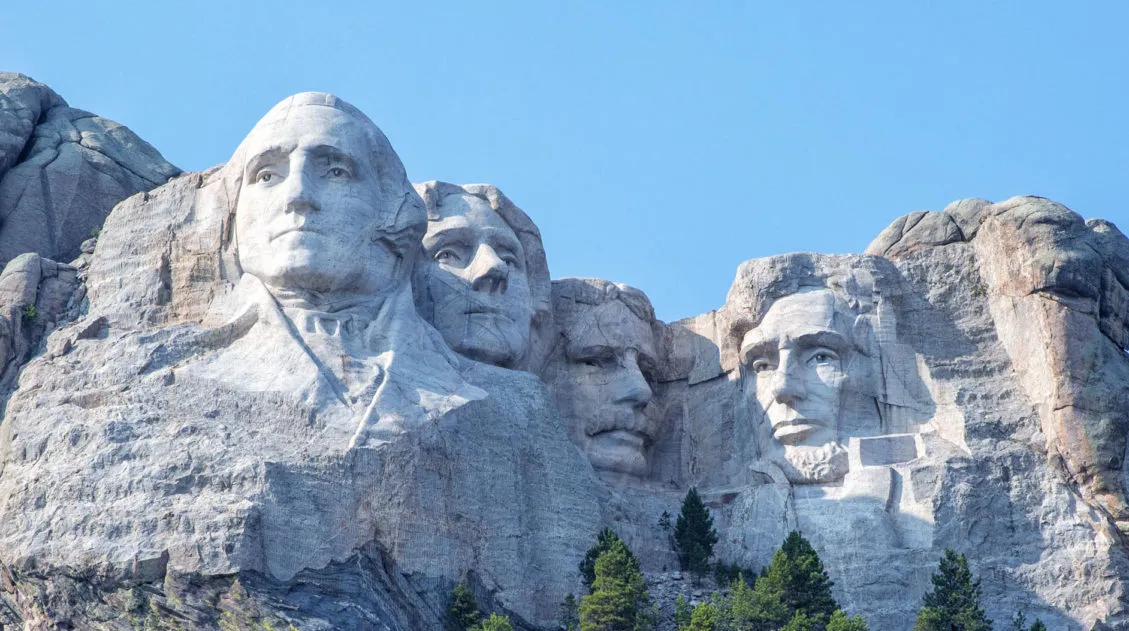
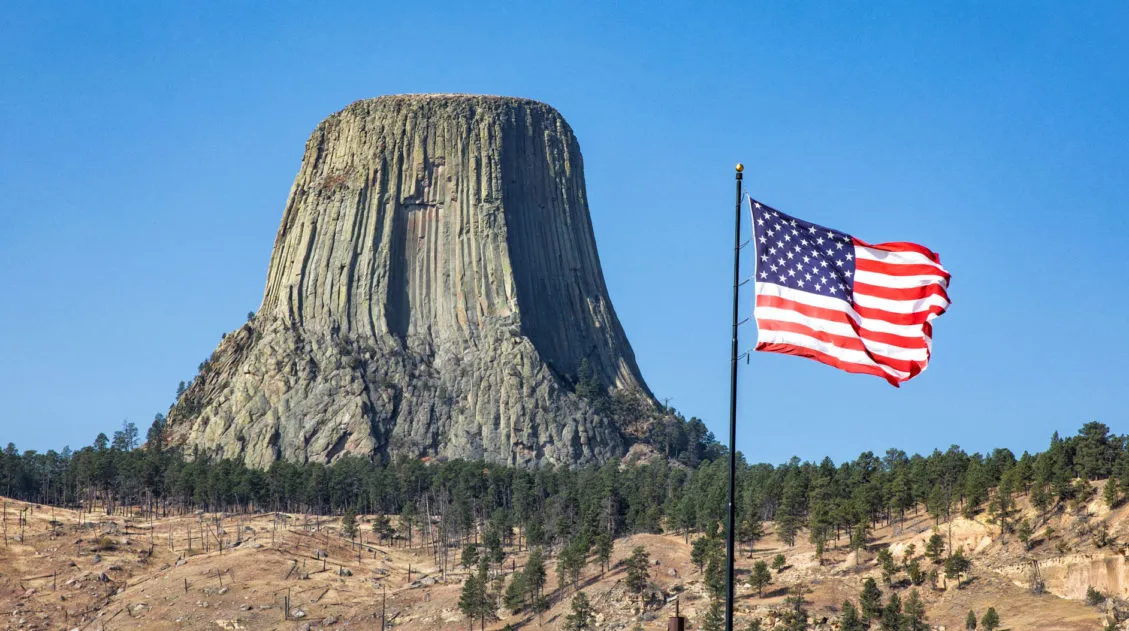
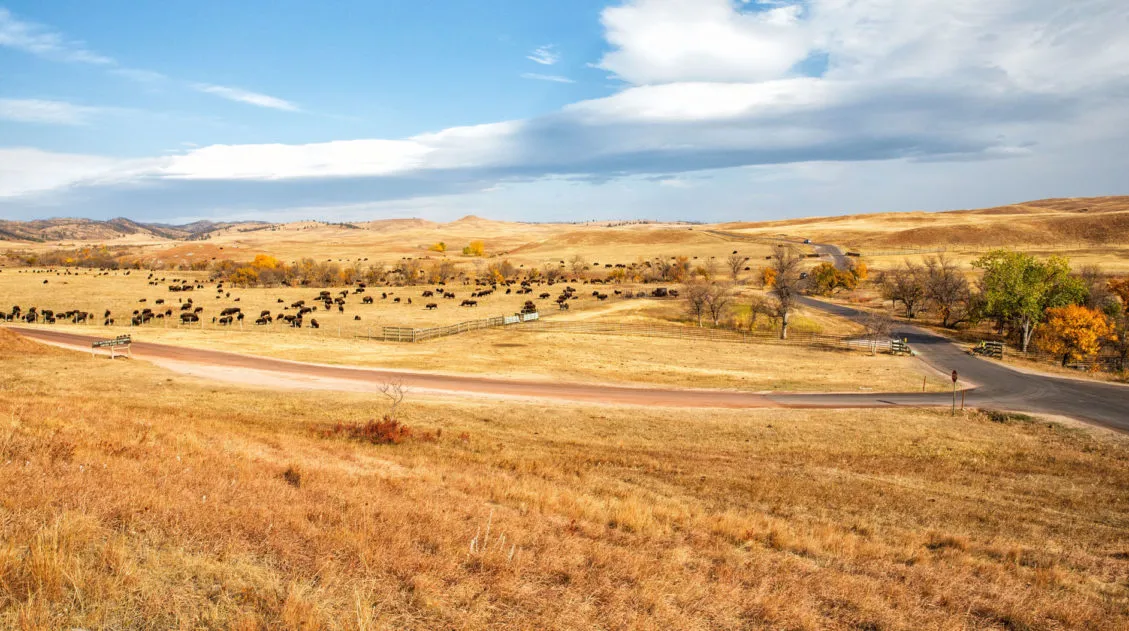
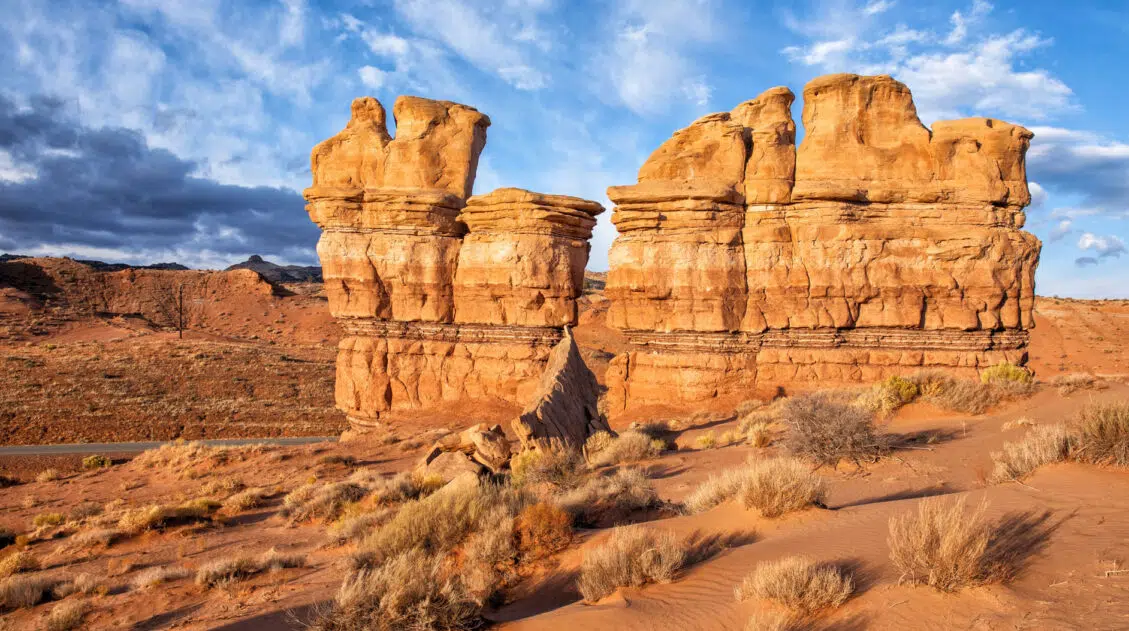
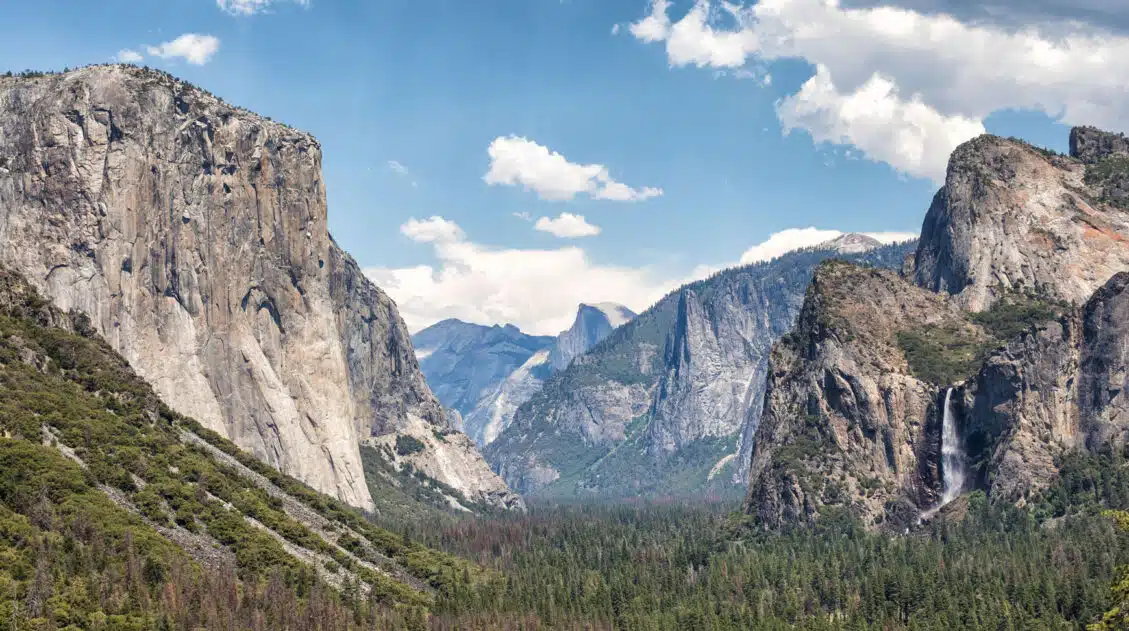
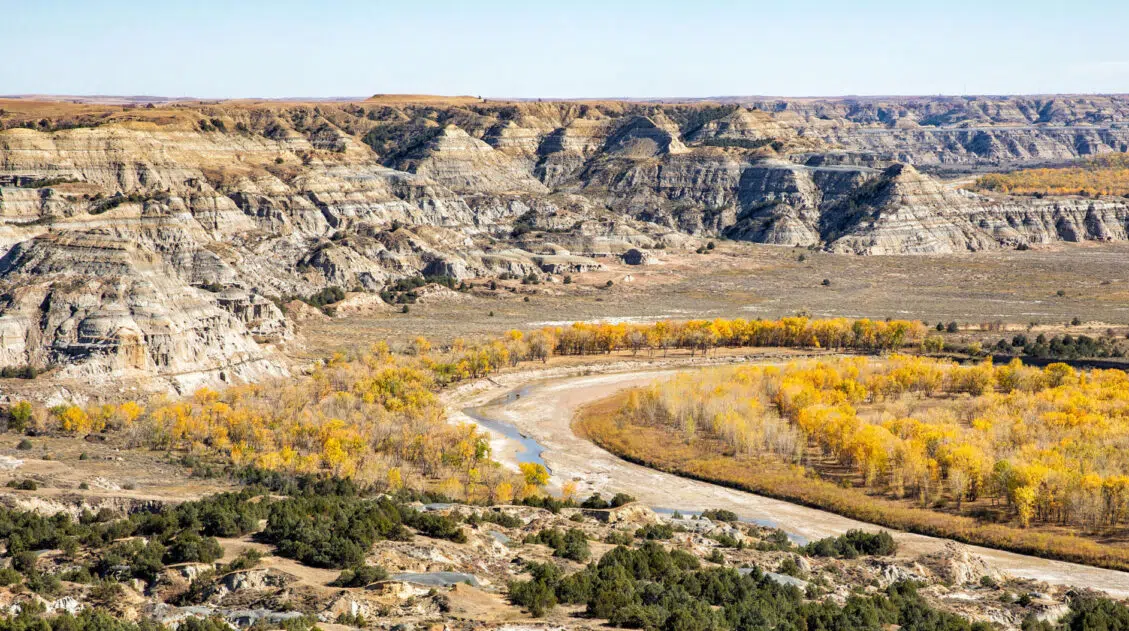
Comments 26